
Racing Signals: Sailing Flag Meanings

Last Updated by
Gabriel Hannon
August 30, 2022
Where other competitions have umpires and referees right next to the players, sailing race committees have to rely on flags to communicate with sailors.
In this article, we are going to explain the meanings of all the flags used at regattas to communicate with sailors. The flags can give information about starting procedures, course information, and on-the-water judging, so a basic understanding is a crucial part of general seamanship.
While nautical flags all have defined meanings in a historical context, they have very specific meanings in the context of racing competition. For instance, in the general nautical world, the Z-flag means that you are in distress and are in need of a tow or relief from a tug boat. At a regatta, the race committee may fly the Z-flag to indicate an additional penalty for any boat that has crossed the line early. Moreover, even though there are certain flags that have well-defined roles, race committees may stipulate additional meanings or introduce new flags via an announcement in the sailing instructions for the event, so we will cover some of these more common changes as well. We will break down the meanings into the various categories of usage.
A secret that I have learned over many years of regattas at every level from proverbial ‘beer-can’ races to national championships is that, as well as both you and the race committee can recite the racing flag rules on land, someone is always going to make a mistake or misunderstand these symbols. That is why I will be going through the official flag meanings and rules from the Racing Rules of Sailing for 2021-2024 to clarify any questions that you might have when the race committee flies a flag that hasn’t been seen since we used Clipper Ships to cross the oceans. Hopefully this article will help break down all the most common signals so that when your friend turns to you and asks ‘is that the flag that tells us it's time to go in,’ you’ll be able to help out!
Table of contents

Flags at the Start
The start of a race is often the most confusing part of a regatta and is where the most flags must be used. We will be going over the rules for the flags at a basic 5-minute start. These can be modified for 3-minute dinghy starts, 5-minute match race starts, 6-minute Olympic starts, or 10-minute big boat starts, but the same logic applies.
A few flags are crucial to set everything up on the starting line prior to the starting sequence.

To begin, the race committee must have an Orange Flag visibly displayed, as this demarks the exact location on the boat from which the line is called. If there is a pin boat, they will often fly an Orange Flag as well, but if it is just a buoy, then the buoy serves as the other end of the line.

Next, the RC will additionally fly the L Flag if they are ready for competitors to check-in at the beginning of the race day. This helps them confirm that everyone is sailing under the correct sail number, which is often a logistical nightmare. They will blow one horn when raising this flag. If this flag is raised at any point later in the day, it is meant to tell competitors to come by the committee boat again.

Finally, the AP Flag is a general purpose postponement flag. The race committee may raise this on land to indicate that the harbor start has been delayed or on the water to indicate that there will be a delay in the starts. While there are other flags that are used for abandonment situations, particularly the N Flag, the AP is commonly used in informal situations. Two sounds accompany the raising of the AP, and it can be said that competitors are ‘under AP’ until it is dropped, along with one sound. If it is dropped on land, competitors may immediately launch. If it is dropped on the water, the next start may begin in as little as one minute.

The final note with the AP Flag is that the race committee may indicate the end of racing for the day by flying ‘AP over A.’ Again, the AP could technically be replaced with the blue and white checkerboarded N Flag, but the two serve very similar purposes at most levels.
Starting Flags

Once the race committee is set up and everyone is ready to go sailing, the next task is to get the right fleets to the starting line for their start. At the warning signal, one loud horn that indicates that the 5-minute countdown to the start has begun, the race committee will raise some type of Class Flag that indicates which type of boat will be starting. Above we have the different class flags for the different competition rigs for the ILCA-Dinghy, formerly known as the Laser, which would be raised to indicate which rig is starting.

This is a convention even if there is only one class on the water. Sometimes this is replaced with raising the Orange Flag itself, or some other flag as laid out in the sailing instructions. Often classes have been assigned a numeral pennant, of which 1-4 are displayed above, in place of the highly specific Class Flags. Still, some flag of this nature goes up at 5-minutes and remains up until go, at which point it is dropped.

At 4-minutes, the RC will sound another horn, known as the preparatory signal, and raise some combination of the above flags.
The P Flag is always required to go up, and it is simply the ‘Prep Flag,’ which signals to the racers that they need to get serious about the race. Once the P Flag is raised, all the right-of-way rules that apply during the start switch on and racers, particularly in team and match racing, are allowed to begin tactically engaging with each other (though in team racing this would happen at minute 2 of the 3-minute start). Moreover, racers can talk with their coaches until the prep signal, and race committees may alter the course up until this moment. Afterwards, all coaching is banned and all course changes on the current leg are not allowed. This belies the fact that a 5-minute starting sequence is actually a 4-minute sequence with a warning signal at 5-minutes, but that is a purely semantic detail.
Depending on how rowdy the competitors are, the race committee may raise any combination of the I, Z, U, or Black Flags. Each of these flags deals with boats that start ‘on-course side’ (OCS), essentially a false start for sailing. If any of these flags is raised, a boat is not allowed to be anywhere within the triangle formed by the starting line and the first mark of the course after the 1-minute signal during the start. These flags essentially help the RC ensure that they can get off a clean start and ensure that they can identify any boats that are OCS at go. When they are flown, the following penalties are added beyond requiring a boat to clear itself by dipping back under the line:
- I Flag: Conventionally referred to as the ‘one-minute rule,’ this requires that any boat over the line after a minute also has to sail around an end of the line in order to start the race fairly. This punishes a boat for being over by potentially making it a little harder to clear themselves if they are over on a large line.
- Z Flag: Often flown in combination with the I Flag, this flag adds that any boat that is OCS will get a 20% penalty on top of their score in that race, regardless of whether they clear themselves or not. This further hurts any boat that is ‘pushing the line’ by ensuring that even if they manage to clear themselves and come back, they will still see an impact on their scoreline that is equivalent to immediately being passed by 20% of the fleet.
- U Flag: Now we’re getting into harsh territory. When the RC is really trying to brush the fleet back off the plate, this flag immediately disqualifies a boat that is over after a minute with no course for redress. If these boats are identified, they tend to be told to stop sailing the race by a notice board at the top mark.
- Black Flag: The black flag serves a very similar purpose to the U Flag, except it is a step harsher. It disqualifies you after a minute and even prevents you from sailing in a restart of the race or a race abandoned halfway through.
The I Flag is by far the most common flag, and is often effective at keeping boats from being over. The U Flag rule was introduced in 2013 as an option and formally codified in the Racing Rules in 2017 and is massively more popular than the Black Flag, which is considered overly punitive. In particular, when many sailors are over in a Black Flag start, such that the RC cannot determine who was over, they are forced to make unfair decisions that carry over to the restart, so the U is now almost universally used in its place. Additionally, as the U has become more popular, people tend to shy away from the Z flag, which is considered cumbersome for scorers and confusing to sailors.
In general, while these flags are supposed to be raised in conjunction with the P Flag, often the RC will only raise the most punitive of the flags, as any of them can essentially be considered as a prep flag.
As the starting sequence continues, any prep flag(s) raised must be lowered at the 1-minute signal. The class flag is then lowered at go, leading to the next category of flags: Recall Flags
Recall Flags
After the pain of raising and lowering all those start flags, the RC then has three possible jobs. If the start is clean, they shout ‘All Clear!’ and can then relax until they have to start another race or record finishes for the race in progress. Unfortunately, this is often not the case, as they likely will need to ‘recall’ certain competitors for being ‘OCS,’ i.e. false starting. They have two choices here.

If only a few, easily-identifiable boats have started early, the RC will raise the X Flag along with a single sound in what is referred to as an individual recall. This indicates to the boats on the course that there are some competitors who are currently OCS and must clear themselves. If the I Flag had been flown for the start, competitors have to round an end; if not, they can just dip back behind the starting line and restart from there.
While the X is suitable on its own to inform a boat that it has been called over, it is an oft practiced courtesy for the RC to hail an OCS boat’s sail number over a megaphone, a radio, or other transmission device. The X Flag is dropped when all OCS boats have cleared themselves or after 4 minutes from go, whichever comes first.

If more boats than can be easily identified are called over, the RC can blow two horns and fly the First Substitute Flag, indicating a general recall. In this case, the race is fully reset and the committee will initiate another entire starting sequence for that fleet. After a general recall, the RC will often, but not always employ the next level of penalty flag for the restart in an attempt to get the race off cleanly.
Sometimes, as in college sailing or as stipulated by other sailing instructions, any general recall immediately implies the I Flag for the next sequence if it had not been flown previously. As such, the RC does not necessarily have to fly the I if it is unavailable. Still, such stipulations are almost always written out explicitly for a given event and are often accompanied by a verbal announcement as a courtesy.
Still, outside some usages of the AP or N Flags to abandon or delay starts already in sequence, these are all the flags that deal with general housekeeping and the starting sequence.
While Underway
While the starting flags are by far the most complicated of the flag rules, there are still other flags to keep track of while racing. The first among these are...
Course Change Flags
Although course changes are relatively rare, race committees often pull them out when conditions change substantially during races or if there has been a problem with one of the marks.

When wind or time constraints require, the race committee may send an official to any mark of the course that no boat has yet rounded and have it raise the S Flag along with two sounds. This indicates that the fleet shall finish at that mark, cutting off the race earlier than written in the sailing instructions.

In the case of any other change to the course, such as a minor adjustment to the angle or distance of an upcoming leg, a race committee boat will go to the preceding mark and raise the C Flag along with repeated sounds.
This is sometimes accompanied by a Red Square or a Green Triangle to indicate that the mark has been moved to port or starboard respectively. Although during less formal events, you can change the positions of any marks so long as there are no competitors currently sailing on that leg of the course, it is considered poor form if at all possible to inform competitors, particularly in longer races. Sailors make decisions based on the position of the marks, and if this has been changed without them noticing, that can drastically affect the outcomes of strategic decisions, so in large competitions the C Flag is a must.

If, meanwhile, something odd has happened to a mark of the course, any official boat may fly the M Flag with repeated signals. This serves to inform the competitors that they have become a replacement for the missing mark. This is relatively uncommon, but anchors do occasionally snap on marks, so it is always good to have a support boat with the M if possible.

Finally, as mentioned before, if conditions have deteriorated to the point that a race is considered no longer possible, due to lack of wind, fear of foul weather, or some form of interference -- I’ve seen it happen because cruise ships wanted to pass through a dinghy course, and you don’t say no to them -- the race committee may abandon the race using the N Flag. Still, this flag is relatively rare as you will often see the AP in its place for convenience, as they are functionally similar.
Miscellaneous Flags
While we have covered the bulk of the flags necessary for racing at any level, there are a few more flags from across different disciplines and classes that are worth mentioning, if only to let you in on these quirky parts of the racing world! This starts with what one could reasonably call…
The Cheating Flag

Calling the O Flag the cheating flag is certainly a bit of a misnomer. The O Flag does, however, suspend Rule 42 of the Racing Rules of Sailing. Rule 42 is particularly notorious, as it bans pumping, rocking, ooching, sculling, and excessive maneuvering, all of which are methods to make your boat go substantially faster. While Rule 42 is worth an article in and of itself, the larger point is that it is meant to keep anyone from gaining an unfair advantage over their competitors.
Certain competitive classes, however, including the Olympic class 470s and Finns and many of the new foiling fleets, allow competitors to ignore Rule 42 in certain conditions, typically in heavy breezes that are referred to as ‘planing’ conditions. There are differences across the classes, but whenever it is allowed and the RC flies the O Flag, Rule 42 is switched off and competitors can ooch, pump, rock, and tack their boats all around the racecourse. This allows for a much more physical style of sailing and is a rule that many different classes and sectors of sailing are beginning to consider.

If conditions no longer meet the threshold for that class’s rules regarding suspension of Rule 42, an official boat will raise the R Flag at some point during the race. They can only do so at a mark of the course so that it is fair to all the competitors throughout the fleet. This is relatively rare, and is normally done between races, but is still a key part of the O Flag rule.
Judge and Umpire Flags
On the topic of Rule 42, there are certain fouls in sailing that can be actively enforced on the water by judges or umpires, depending on the context.
Rule 42 is enforced by judges with a Yellow Flag, which they will point at an offending boat along with a sound signal and a direct sail number hail. That boat may clear themselves from their first Yellow Flag by taking their two-turn penalty, but, unless otherwise noted in the sailing instructions, any subsequent violation can entail disqualification.
Finally, certain levels of modern match and team racing, with the addition of high-performance racing like SailGP, have full on-the-water umpires who actively follow the racing to make calls on fouls and other plays. While this is not the spot to go through the intricacies of team and match race calls, the basic gist is as follows.
In any interaction, any boat involved in the race may call in the umpires if they believe that their opponent has fouled them. If the opponent clears themselves quickly, essentially admitting fault, the umpires will not get involved. If no boats clear themselves, the umpire has to make a call on whether there has been a foul. If they determine that the maneuvers were clean, they will make one sound and fly a Green Flag, thus exonerating all boats in the interaction. If they determine there was a foul, they will fly a Red Flag with a singular sound and hail the offending boat.
Beyond that, if a boat is found to have broken a rule not related to an interaction, the umpires may come in and fly the Red Flag without being directly invited into the situation. Further, if a boat is found to be in violation of sportsmanship or refuses to take a penalty as assessed by an umpire, the umpire may fly a Black Flag, disqualifying them from the race.
While there are differences at each event and in each discipline, these general guidelines are followed in most umpired races, with specific flags used at various events, generally depending on availability.
With that, we have made it from land, through the start, a few general recalls, all the way to umpire flags! I hope this has helped you get a grasp of the various flags used across sailing. While this has not scratched the specifics of the various alterations made for kiteboards and windsurfers, nor some of the annoyances of protest flags and more, we have gone through the bulk of regularly used race committee and umpire signals.
The ‘Wear Your Life Jacket!’ Flag

Finally, we have a safety flag. At big boat regattas, the race committee may, if it chooses, fly the Y Flag at any point prior to a start to inform competitors that they must wear personal floatation devices, which is not always strictly necessary.
The Most Important Flag
While I wish I could tell you that everyone uses their flags properly and accompanies them with the proper timing and sound signals, that is far from the truth. Everyone’s flag set is slightly incomplete or out of date, and invariably there is going to be a miscommunication somewhere, where the race committee forgets to put the I Flag up but really should have; I’ve certainly done that a time or two. Still, there’s nothing quite like being on the water, so, despite the endless mutual griping between racers and their race committees, hopefully everyone comes back to shore flying the ‘Happy Flag.’
Happy sailing!
Related Articles
I have been sailing since I was 7 years old. Since then I've been a US sailing certified instructor for over 8 years, raced at every level of one-design and college sailing in fleet, team, and match racing, and love sharing my knowledge of sailing with others!
by this author
Most Recent

What Does "Sailing By The Lee" Mean?
Daniel Wade
October 3, 2023

The Best Sailing Schools And Programs: Reviews & Ratings
September 26, 2023
Important Legal Info
Lifeofsailing.com is a participant in the Amazon Services LLC Associates Program, an affiliate advertising program designed to provide a means for sites to earn advertising fees by advertising and linking to Amazon. This site also participates in other affiliate programs and is compensated for referring traffic and business to these companies.
Similar Posts

How To Choose The Right Sailing Instructor
August 16, 2023

Basics Of Sailboat Racing Explained
May 29, 2023

Cost To Sail Around The World
May 16, 2023
Popular Posts

Best Liveaboard Catamaran Sailboats
December 28, 2023

Can a Novice Sail Around the World?
Elizabeth O'Malley
June 15, 2022

4 Best Electric Outboard Motors

How Long Did It Take The Vikings To Sail To England?

10 Best Sailboat Brands (And Why)
December 20, 2023

7 Best Places To Liveaboard A Sailboat
Get the best sailing content.
Top Rated Posts
Lifeofsailing.com is a participant in the Amazon Services LLC Associates Program, an affiliate advertising program designed to provide a means for sites to earn advertising fees by advertising and linking to Amazon. This site also participates in other affiliate programs and is compensated for referring traffic and business to these companies. (866) 342-SAIL
© 2024 Life of Sailing Email: [email protected] Address: 11816 Inwood Rd #3024 Dallas, TX 75244 Disclaimer Privacy Policy

Sailboat Racing Flags and Signals
Are you ready to hit the open water and experience the exhilarating world of sailboat racing? Before you set sail, it’s crucial to understand the meaning behind the various flags and signals used during races . In this article, we’ll dive into the International Code of Signals, explore preparatory, course, protest, abandonment, penalty, safety, and emergency signals.
Get ready to navigate the racing scene with confidence and sail towards victory!
Key Takeaways:
- The International Code of Signals consists of 26 flags and 10 numeral pennants , which are used for safety and communication on the water.
- Preparatory flags and signals such as the ‘P’ flag, ‘I’ flag, ‘S’ flag, and ‘X’ flag are crucial for sailors to understand and respond to, as they indicate important instructions and changes in the race .
- Course and mark signals provide information about the direction to sail and the marks themselves, helping sailors navigate the racecourse effectively and make informed decisions.
- Protest flags and signals, including the red flag with a white cross, blue flag, yellow flag, and red flag, are important for ensuring fair competition and resolving disputes between boats.
Table of Contents
The International Code of Signals
You should learn the International Code of Signals, as it consists of 26 flags and 10 numeral pennants that can convey important messages while sailing. These signals are essential for maintaining safety and communication on the water. By familiarizing yourself with this code, you can ensure that you’re prepared for any situation that may arise while sailing.
The International Code of Signals is a universal system used by sailors around the world . Its simplicity and effectiveness make it a valuable tool for communication at sea. Each flag and pennant represents a specific message or instruction , allowing sailors to convey important information without relying on verbal communication.
Learning the International Code of Signals is particularly important for those who desire freedom on the water. By understanding and using these signals, you can communicate with other boats, request assistance, or inform others of potential dangers. This knowledge empowers you to navigate the open seas confidently and independently.
In addition to enhancing your safety, knowing the International Code of Signals also allows you to fully immerse yourself in the sailing community. It’s a language shared by sailors worldwide, connecting you to a global network of adventurers who share your love for the sea.
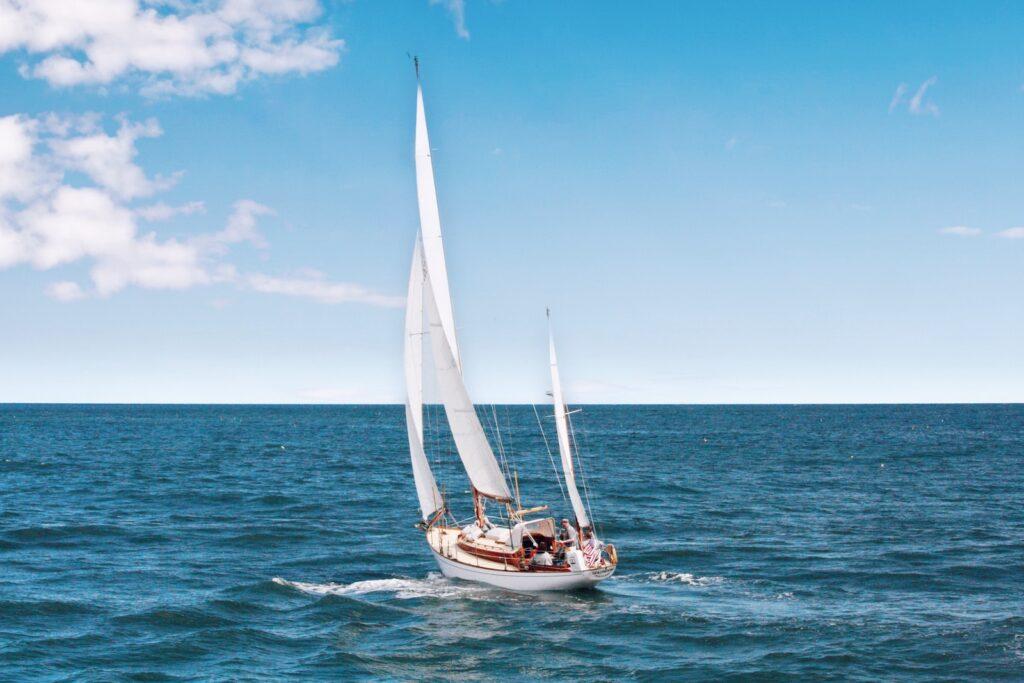
Preparatory Flags and Signals
Make sure to brush up on the meaning of the preparatory flags and signals before your next sail, as they can indicate important information about the race or event. These flags and signals are essential for every sailor who desires the freedom to compete in sailboat racing.
When you see the preparatory flag ‘P,’ it signals that the race is about to start, and you should be ready to go . Another important signal is the ‘I’ flag, which indicates a change in the starting line . Pay attention to this flag, as it could affect your strategy and give you a competitive advantage.
During the race, you may encounter the ‘S’ flag, which means you must take a penalty for a rule infringement . Don’t ignore this flag, as it could cost you valuable time and position. Additionally, the ‘X’ flag indicates that the race has been abandoned or postponed . If you see this flag, be prepared to follow the instructions given by the race committee.
Understanding and responding to these preparatory flags and signals is crucial for any sailor who values their freedom to compete in sailboat racing. So, take the time to familiarize yourself with them and be ready to navigate the racecourse with confidence and skill.
Course and Mark Signals
When approaching a mark, be sure to keep an eye out for the appropriate course and mark signals to navigate the racecourse effectively. These signals are crucial for your success as a sailor. Freedom is at the core of sailboat racing, and understanding these signals will give you the freedom to make informed decisions on the water.
As you approach a mark, look for the course signal displayed by the race committee . This signal indicates the direction you need to sail after rounding the mark. It could be a simple arrow pointing left or right, or it may consist of multiple arrows indicating a more complex course. Pay attention to this signal to ensure you take the correct path and stay on course.
In addition to the course signal, keep an eye out for mark signals . These signals provide important information about the mark itself. They can indicate a change in the mark’s position, a change in the rounding direction, or even a change in the mark itself . Understanding these signals will help you anticipate any changes in the racecourse and adjust your strategy accordingly.
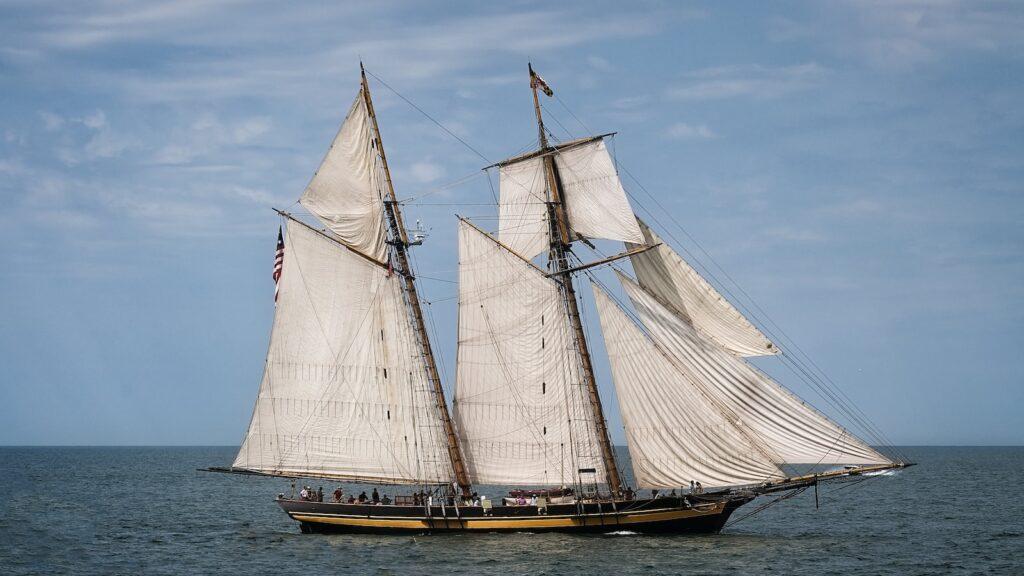
Protest Flags and Signals
When you see a protest flag in sailboat racing, it’s important to understand its meaning. The most common protest flag is a red flag with a white cross, indicating that a boat is protesting another boat for a rule violation.
If you find yourself in a protest situation, it’s crucial to know how to resolve it properly to ensure fair competition.
Meaning of Protest Flags
You should familiarize yourself with the meaning of protest flags before participating in sailboat racing. Understanding these flags is essential to ensure fair competition and maintain the freedom that racing represents.
Here are three important protest flags and their meanings:
- Blue Flag : This flag indicates that a boat intends to protest another boat for breaking a rule. It’s important to keep a close eye on this flag, as it signifies a potential dispute between competitors.
- Yellow Flag : When this flag is displayed, it means that a protest hearing is being held. This flag warns all participants to be cautious and respectful during the hearing process.
- Red Flag : The red flag is raised when a protest has been withdrawn. It signifies that the dispute has been resolved or abandoned.
Common Protest Signal
Don’t underestimate the significance of familiarizing yourself with the common protest signal during sailboat racing. It’s crucial to understand this signal as it can greatly impact your race and the freedom you desire on the open water.
When you see a boat raising a protest flag, typically a red flag, it means that they believe another boat has violated a racing rule. This signal signifies their intention to file a protest against the other boat’s actions.
As a sailor, knowing this signal allows you to be proactive in avoiding potential conflicts and ensuring fair competition. By being aware of the common protest signal, you can navigate the racecourse with confidence, knowing that you’re respecting the rules and upholding the freedom that sailboat racing represents.
Resolving Protest Situations
To effectively resolve protest situations during sailboat racing, it’s important that you remain calm and cooperate with the race officials. Remember, your freedom to enjoy the race depends on your ability to handle these situations with grace and respect.
Here are three key points to keep in mind:
- Communicate clearly: When presenting your protest, make sure your message is concise and easily understood. Use simple language and avoid any unnecessary aggression or hostility.
- Follow procedures: Familiarize yourself with the rules and regulations of the race. Understand the proper steps to take when filing a protest and be prepared to provide any evidence or witnesses that support your case.
- Be open to compromise: Sometimes, finding a middle ground is the best way to resolve a protest situation. Listen to the other party’s perspective and be willing to negotiate a solution that’s fair for everyone involved.
Abandonment Flags and Signals
Grab the binoculars and look for any abandonment flags or signals on nearby boats. As a sailor who desires freedom, you understand the importance of being aware of potential dangers on the water. Abandonment flags and signals are crucial in ensuring the safety of all sailors. These flags and signals indicate that a boat or its crew may require assistance or are in need of immediate rescue. By spotting these flags or signals, you can take action and provide the necessary help, ensuring that everyone can continue enjoying the freedom of sailing.
To help you better understand the various abandonment flags and signals, here is a table highlighting some of the most commonly used ones:
Penalty Flags and Signals
Keep an eye out for any penalty flags or signals, as they can indicate rule violations and affect the outcome of the race. In sailboat racing, it’s crucial to understand the meaning behind these flags and signals to ensure fair competition and maintain the spirit of freedom on the water. Here are three key points to consider:
- Penalty flags: These flags are raised by race officials to indicate a rule violation by a boat. The flags come in different colors, such as yellow or blue, and are typically displayed alongside a number, representing the specific rule broken. Be vigilant in spotting these flags, as they can result in time penalties or disqualification.
- Signals from other boats: Pay attention to the actions of other boats around you. If a competitor raises a flag or makes a specific hand signal, it could be a warning that you have violated a rule. Keep an open mind and be ready to adjust your tactics to avoid penalties.
- Communication with race officials: If you have any doubts or concerns about a potential rule violation, don’t hesitate to contact the race committee. They’re there to ensure fairness and resolve any disputes that arise during the race. Maintain a respectful and open line of communication to uphold the principles of freedom and fair play.
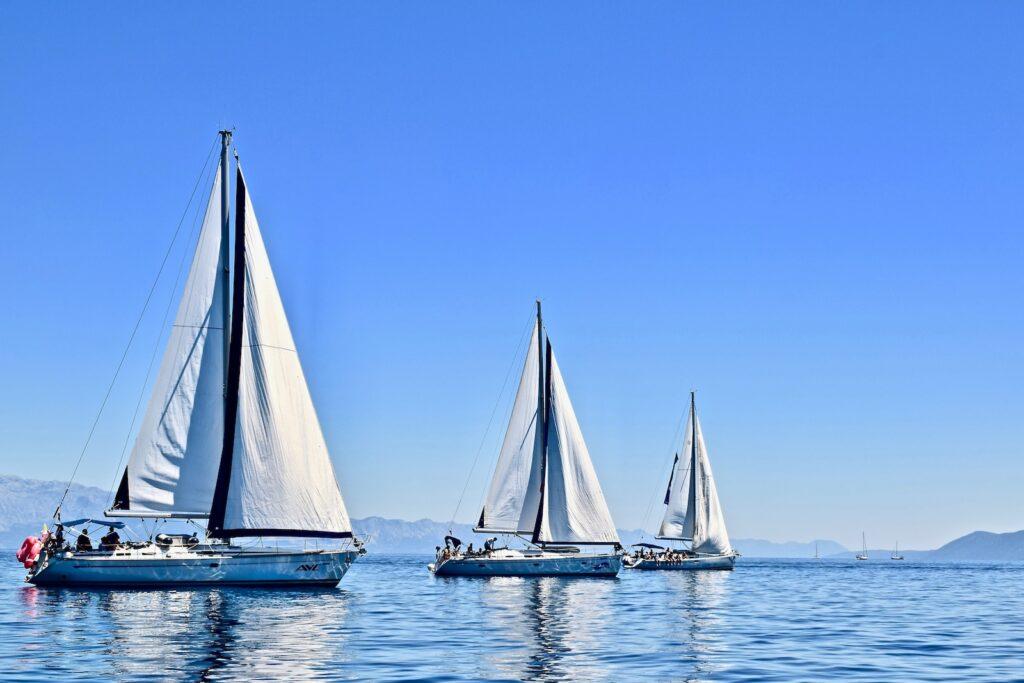
Safety and Emergency Signals
If you encounter any safety or emergency signals during the race, please follow the instructions provided and ensure the well-being of yourself and others. Your safety is of utmost importance, and it is crucial to understand the meaning behind these signals. To help you navigate the race course, here is a table outlining some common safety and emergency signals you may encounter:
So, now you know the various sailboat racing flags and signals used in competitions. The International Code of Signals provides a standardized system for communication on the water.
From preparatory flags to protest flags, each signal plays a vital role in ensuring fair and safe races. Understanding these signals is crucial for all sailors and race officials.
By following the correct flags and signals, participants can navigate the racecourse effectively and respond appropriately to any emergencies or penalties that may arise.
Related posts:
Leave a Reply Cancel reply
Your email address will not be published. Required fields are marked *
Save my name, email, and website in this browser for the next time I comment.
RACE SIGNALS

Set Sail to Victory: Mastering Sailboat Racing Flags and Signals
Sailboat racing is a thrilling and challenging sport that requires skill, strategy, and knowledge of sailing rules and regulations. One of the essential components of sailboat racing is the use of flags and signals to communicate important information to the sailors.
Sailboat racing flags and signals are a standardized system used to convey messages about the course, starting times, penalties, and other critical information. In this article, we will explore the various sailboat racing flags and signals and their importance in the sport.
The Importance of Sailboat Racing Flags and Signals
Sailboat racing flags and signals are a set of visual cues used to communicate important information to sailors during a race. These signals can indicate the start and end of a race, changes in wind direction, or other important information that can affect a sailor’s strategy.
Understanding these signals is critical for any sailor who wants to compete in a sailboat race. Some common sailboat racing flags and signals include the “preparatory” flag, which indicates the start of the race is imminent, and the “postponement” flag, which indicates a delay in the start of the race.
Sailboat racing flags and signals are essential to the smooth and safe conduct of sailboat races. Without these flags and signals, sailors would be unable to navigate the race course safely or understand the starting times, course changes, or penalties.
Flags and signals provide a standardized system of communication that ensures that all sailors have the same information at the same time. This, in turn, promotes fair competition and ensures that all sailors have an equal opportunity to win.
The Basic Sailboat Racing Flags and Signals
The World Sailing ( WS ) is the world governing body for the sport of sailing (until 14 November 2015 named as International Sailing Federation or ISAF) has established a standardized system of sailboat racing flags and signals that are used worldwide. These flags and signals communicate essential information about the race, such as the starting times , course changes , penalties , and finish line . Below are the most common sailboat racing flags and signals:
The Preparatory Signal
The preparatory signal is the first signal made before the start of a sailboat race. This signal indicates that the race is about to start and that the boats should be prepared to start racing. The preparatory signal is usually made 5 to 10 minutes before the start of the race, depending on the size and type of race.
During the preparatory signal, the race committee displays the preparatory flag, which is a solid white flag with a blue horizontal stripe. The preparatory flag is displayed until the starting signal is made. Boats that cross the starting line before the starting signal is made are considered to have started early and may be penalized.
The Starting Signal
The starting signal is the second signal made in a sailboat race. This signal indicates that the race has officially started, and the boats can begin racing. The starting signal is usually made immediately after the preparatory signal, although there may be a delay if conditions are not suitable for racing.
The starting signal is made using the starting gun or horn. Boats must cross the starting line after the starting signal is made, or they will be considered to have started late and may lose valuable time.
The General Recall Signal
The general recall signal is made when the race committee determines that the starting sequence has not been fair or equal for all boats. This signal indicates that the race will be restarted.
During the general recall signal, the race committee displays the first substitute flag, which is a blue and white flag with a blue square in the center. Boats must return to the starting line and prepare to start again.
The Individual Recall Signal
The individual recall signal is made when a specific boat is identified as starting early. This signal indicates that the identified boat must return to the starting line and start again.
During the individual recall signal, the race committee displays the X flag, which is a black flag with a white square in the center. The identified boat must return to the starting line and start again after all other boats have started.
The Postponement Signal
The postponement signal is made when conditions are not suitable for racing. This signal indicates that the start of the race will be delayed until conditions improve.
During the postponement signal, the race committee displays the AP flag, which is a solid blue flag. Boats must return to the starting area and wait for further instructions.
The Abandonment Signal
The abandonment signal is made when conditions become too dangerous for racing. This signal indicates that the race will be abandoned, and all boats must return to shore.
During the abandonment signal, the race committee displays the N flag, which is a solid black flag. Boats must stop racing and return to shore immediately.
The Shortened Course Signal
The shortened course signal is made when conditions are not suitable for completing the full race course. This signal indicates that the race course will be shortened to ensure the safety of the boats and sailors.
During the shortened course signal, the race committee displays the S flag, which is a solid white flag with a blue square in the center. Boats must complete the shortened course and cross the finish line.
The Finish Signal
The finish signal is the final signal made in a sailboat race. This signal indicates that the race is over, and the boats have completed the race course. The finish signal is usually made when the boats cross the finish line.
During the finish signal, the race committee displays the finishing flag, which is a solid white flag with a blue vertical stripe. Boats must cross the finish line and complete the race. The boats are then ranked based on the order in
Additional Sailboat Racing Flags and Signals
In addition to the basic sailboat racing flags and signals, there are other flags and signals used in sailboat racing. These flags and signals communicate additional information about the race, such as penalties and rule enforcement. Below are some additional sailboat racing flags and signals:
The Penalty System
In sailboat racing, the penalty system is an important mechanism to ensure fair play and discourage cheating. The penalty system involves the use of penalty turns, which is a requirement for a boat to make a 360-degree turn as a result of committing a rule violation. The penalty turns must be completed as soon as possible, and failure to do so will result in further penalties.
The penalty system is signaled by the display of the “yellow flag” by the race committee boat. This flag is accompanied by a horn blast, which signifies that a penalty has been given to a boat. If a boat receives a penalty, it must complete the penalty turns as soon as possible.
The Black Flag Rule
The black flag rule is a sailing rule that is used to discourage boats from starting too early. Under this rule, if a boat is over the starting line when the starting signal is given, it is disqualified from the race.
The black flag is signaled by displaying a black flag with a white square in the middle. This flag is displayed with the one-minute signal before the start of the race. If a boat is over the starting line when the race starts, and the black flag is displayed, the boat is disqualified.
The Blue Flag Rule
The blue flag rule is used to indicate that a boat is in danger and requires assistance. The blue flag is displayed by a boat that requires assistance, and this signal must be acknowledged by other boats in the race.
The blue flag is displayed by a boat in distress or requiring assistance, and other boats must immediately make way for the distressed boat. If a boat fails to acknowledge the blue flag signal, it may be subject to penalties.
The Red Flag Rule
The red flag rule is used to s ignal that a race has been stopped due to an emergency situation . The red flag is displayed by the race committee boat, and all boats must immediately stop racing.
If the red flag is displayed, all boats must immediately stop racing and proceed to the designated area. The race will be restarted once the emergency situation has been resolved.
Sailboat racing flags and signals are a crucial part of the sport of sailboat racing. They provide a standardized system of communication that ensures fair competition and safe racing. Understanding these flags and signals is essential for all sailors who want to compete in sailboat racing.

What happens if a boat does not follow the sailboat racing flags and signals?
If a boat does not follow the sailboat racing flags and signals, it may be penalized or disqualified from the race.
Are sailboat racing flags and signals the same worldwide?
Yes, sailboat racing flags and signals are standardized worldwide by the International Sailing Federation (ISAF).
What is the penalty for starting early in sailboat racing?
The penalty for starting early in sailboat racing is usually a 360-degree turn penalty.
How are safety rules enforced in sailboat racing?
Safety rules are enforced in sailboat racing using the red flag rule. If a boat is identified as posing a safety risk, it will be disqualified from the race.
Can sailboat racing flags and signals change during a race?
Yes, sailboat racing flags and signals can change during a race due to weather conditions or other safety concerns.
About the author
I worked as an officer in the deck department on various types of vessels, including oil and chemical tankers, LPG carriers, and even reefer and TSHD in the early years. Currently employed as Marine Surveyor carrying cargo, draft, bunker, and warranty survey.
Leave a Reply Cancel reply
Your email address will not be published. Required fields are marked *
Save my name, email, and website in this browser for the next time I comment.
Latest posts

What Are the Most Common Shipbuilding Woods?
While shipbuilders have switched to other practices, wood still has a place in the maritime industry. The numerous types available mean manufacturers have myriad options, so here’s a guide on shipbuilding woods.

Fiberglass vs. Steel: Which Is More Reliable?
Shipping professionals should get the most from their investment, so which is more reliable: steel vs. fiberglass? Here’s how to determine the better option.

What Does a Longshoreman Do?
Longshoremen play a critical role in the global supply chain, bringing billions worth of cargo into the country. So what does a longshoreman do exactly?
The Fascinating World of Maritime Flags: Unraveling Their Meanings and Significance
- The World of Maritime Flags: Unraveling Their Meanings and Significance
Maritime flags have a rich history and serve as essential communication tools on the high seas. These colorful emblems fluttering in the wind are not just mere decorations; they carry important messages that convey a range of information to sailors and boaters. In this article, we will explore the captivating world of maritime flags, unravel their meanings, and understand their significance in naval communication. So, hoist your sails, and let's embark on this journey!
1. Introduction
Maritime flags have been used for centuries as a means of communication at sea. From the earliest sailboats to modern naval vessels, these flags have played a vital role in conveying messages, identifying ships, and signaling important information. Each flag represents a unique combination of colors, patterns, and symbols that carry specific meanings and serve various purposes.
2. The History of Maritime Flags
The history of maritime flags can be traced back to ancient times when early seafarers used simple flags to communicate with one another. Over time, these flags evolved into more sophisticated systems, incorporating a wide range of symbols and signals. From the Greek and Roman navies to the Age of Exploration, maritime flags have witnessed significant developments, reflecting the advancements in seafaring and naval communication.
3. Types of Maritime Flags
Maritime flags can be categorized into several types based on their purpose and usage. Let's explore some of the most common types:
3.1 Nautical Flags
Nautical flags are primarily used by recreational boaters to convey messages and signals in a maritime setting. These flags often represent specific letters or phrases and are essential for effective communication on the water.
3.2 Naval Flags
Naval flags, on the other hand, are associated with the military and represent the authority, rank, and nationality of a naval vessel. These flags carry historical significance and are an integral part of naval traditions and ceremonies.
3.3 Signal Flags
Signal flags are used to communicate messages between ships, especially when radio communication is not available or restricted. Each flag represents a specific letter or code, allowing sailors to spell out words and phrases using a combination of flags.
3.4 Alphabet Flags
Alphabet flags, also known as spelling flags, are an essential part of the International Code of Signals. They enable sailors to spell out names, words, or important messages using a standardized set of flags representing individual letters.
3.5 International Signal Flags
International signal flags serve as a universal system of communication at sea. These flags are recognized and understood by sailors from different nations, enabling effective communication and conveying crucial information regardless of language barriers.
Read our top notch articles on topics such as sailing, sailing tips and destinations in our Magazine .
Marine signal flags
4. Flag Colors and Combinations
Maritime flags come in a variety of colors and combinations. Let's explore some of the most common ones and their meanings:
4.1 Black, Red, and Yellow Flag
The black, red, and yellow flag signifies general diving activities. It is commonly used to mark the presence of divers in the water and warns other vessels to exercise caution in the area.
4.2 Red, White, and Black Flag
The red, white, and black flag, often referred to as the "Jolly Roger," is traditionally associated with pirates and signifies their presence. However, in contemporary usage, it is also employed as a racing flag in some maritime events.
4.3 Blue, White, and Red Flag
The blue, white, and red flag is a tricolor pattern often associated with coastal regions. It represents patriotism, national identity, and is commonly seen on flags of countries like France and the Netherlands.
4.4 Red, Blue, and Yellow Flag
The red, blue, and yellow flag represents a combination of primary colors and is often associated with countries like Colombia and Venezuela. It symbolizes the rich cultural heritage and history of these nations.
4.5 Blue, Red, and Yellow Flag
The blue, red, and yellow flag is another combination of primary colors, frequently seen on flags of countries like Sweden and Ukraine. It carries different meanings and symbolism based on the specific national context.
4.6 Blue, White, and Black Flag
The blue, white, and black flag signifies specific nautical activities and is often used to indicate the presence of boats or vessels engaged in those activities, such as fishing or recreational boating.
4.7 White, Blue, and Red Horizontal Flag
The white, blue, and red horizontal flag is a tricolor pattern commonly associated with countries like Russia and the Czech Republic. It represents national identity and patriotism.
4.8 Green Flag with Yellow Diamond
The green flag with a yellow diamond is often used to signal permission to proceed or enter a particular area. It is frequently employed in sailing regattas and races to indicate the starting point or line.
4.9 Red, Yellow, and Purple Flag
The red, yellow, and purple flag is a combination of vibrant colors and is often used in maritime signaling to indicate potential danger or hazardous conditions.
5. Understanding Flag Meanings
Maritime flags carry various meanings and serve different purposes. Let's explore some of their common applications:
5.1 Ships and Boat Identification
Maritime flags are crucial for identifying ships and boats at sea. They provide essential information about the vessel's nationality, registration, and purpose, aiding in navigation and establishing communication between vessels.
5.2 Signaling and Communication
Flags are widely used for signaling between ships, conveying messages, and transmitting information. Whether it's a distress signal, a request for assistance, or a simple greeting, maritime flags facilitate effective communication on the water.
5.3 Racing and Regatta Flags
In sailing races and regattas, flags play a vital role in indicating the start, finish, and various stages of the race. Each flag has a specific meaning and is used to communicate important instructions and rules to the participating boats.
5.4 Navigational Warnings
Certain maritime flags are used to warn other vessels about specific conditions or hazards in a particular area. These flags serve as visual cues, alerting sailors to exercise caution, change course, or take appropriate actions to ensure safety.
6. The Significance of Naval Flags
Naval flags hold immense significance in the world of maritime operations and naval traditions. Let's explore some of their key roles:
6.1 Symbolism and Tradition
Naval flags symbolize the power, authority, and heritage of a nation's naval forces. They carry historical significance and are often associated with heroic naval exploits and traditions that have been passed down through generations.
6.2 Establishing Authority and Rank
Naval flags play a crucial role in establishing authority and identifying the rank of naval officers. From the commanding officer's flag to the admiral's flag, each flag represents a specific position of leadership and command hierarchy.
6.3 Honoring National Identity
Naval flags proudly display a nation's colors and insignia, representing its sovereignty and national identity. They evoke a sense of patriotism and unity among sailors and serve as a visual reminder of their allegiance to their country.
7. Conclusion
Maritime flags are more than mere pieces of cloth fluttering in the wind. They are a language of their own, with each flag and combination carrying specific meanings and serving distinct purposes. From communicating messages to identifying ships and honoring traditions, maritime flags have been an integral part of seafaring for centuries. So, the next time you see a colorful flag adorning a ship or boat, remember that it is more than just a decorative element—it's a means of communication and a window into the fascinating world of maritime history and culture.
So what are you waiting for? Take a look at our range of charter boats and head to some of our favourite sailing destinations .
FAQ Naval flags meaning
What are alphabet flags used for?
Alphabet flags, also known as spelling flags, are used to spell out names, words, or messages in a standardized manner. They enable sailors to communicate clearly and effectively, especially in situations where verbal or radio communication is challenging.
Do maritime flags have universal meanings?
While some maritime flags have universally recognized meanings, such as distress signals or racing flags, others may have specific connotations based on regional or national contexts. It's essential to consult flag signal charts and understand the local maritime customs and regulations when interpreting flags.
Can anyone use maritime flags on their boats?
Yes, recreational boaters can use maritime flags to convey messages or signals while on the water. However, it's crucial to familiarize oneself with the proper usage and meaning of different flags to ensure effective communication and adherence to maritime regulations.
How many types of maritime flags are there?
Maritime flags can be categorized into various types, including nautical flags, naval flags, signal flags, alphabet flags, and international signal flags.
What do the colors of maritime flags represent?
The colors of maritime flags have symbolic meanings. For example, red often represents danger or warning, while blue may represent peace or authority, depending on the context and flag design.
What is the significance of racing flags in sailing events?
Racing flags serve as visual cues for sailors participating in regattas or races. They indicate the start, finish, and various stages of the race, enabling sailors to follow the rules and instructions set by the race organizers.
How have maritime flags evolved over time?
Maritime flags have evolved significantly over the centuries, incorporating new symbols, patterns, and signaling systems. The advancements in technology, such as radio communication, have led to changes in flag usage but have not diminished their importance in maritime traditions and practices.
Nautical Flags and Their Meanings
International Code Flags (also see Multiple Flags Signal Codes )
Race Committee Flags
Yacht Club Officer Flags
Miscellaneous Flags
home | about | contact | advertising | privacy | link to us
Copyright © MarineWaypoints.com. All rights reserved.

Boat Sailor
Sailing flags 101: navigating maritime communication with confidence.
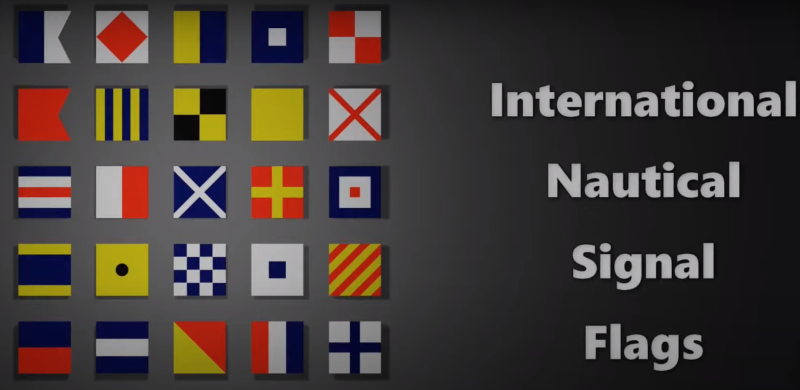
Ahoy, fellow sailors and sea enthusiasts! If you’ve ever set sail on the open waters, you’re likely familiar with the vibrant array of flags fluttering aboard vessels. These seemingly humble pieces of fabric hold significant importance in maritime communication, allowing sailors to convey messages, assert their intentions, and navigate safely. Join me on this journey as we delve into the world of sailing flags, decoding their meanings, understanding their etiquette, and unlocking the secrets they hold.
Introduction to Sailing Flags
Sailing flags, often referred to as nautical flags, play a pivotal role in the language of the sea. These distinct flags serve as visual signals, enabling sailors to communicate with one another across the vast expanses of water. Whether you’re a seasoned mariner or a novice adventurer, understanding the art of flag communication is essential for a smooth and safe voyage.
Understanding Different Types of Sailing Flags
The ocean is a realm governed by its own set of rules, and sailing flags provide the key to deciphering these rules. From the International Code of Signals flags that convey messages in an internationally recognized manner, to the specialized flags used in competitive racing, each type of flag holds a unique significance that guides sailors through a myriad of situations.
Decoding Sailing Flag Colors and Symbols
Colors and symbols within sailing flags are not mere aesthetics; they carry vital meanings that help sailors convey messages effectively. From the bold red of a “C” flag representing “Affirmative” to the stark white and blue of the “H” flag indicating “I have a pilot on board,” these visual cues serve as a silent language shared by sailors worldwide.
Choosing the Right Sailing Flags for Your Vessel

Proper Display and Etiquette of Sailing Flags
As with any language, flag communication has its own set of protocols. The position and arrangement of flags on your vessel communicate specific messages to fellow sailors and maritime authorities. Mastering flag etiquette not only enhances communication but also demonstrates your respect for time-honored seafaring traditions.
Enhancing Safety with Sailing Flags
Safety at sea is paramount, and sailing flags play a crucial role in avoiding collisions and navigating tricky waters. By hoisting the right flags, you signal your intentions and help prevent misunderstandings among vessels. Clear communication through flags can be a lifesaver in situations where verbal communication isn’t feasible.
Sailing Flags in Competitive Sailing
In the world of competitive sailing, flags take on an even more strategic role. Racing flags convey information about starts, penalties, and course changes, giving sailors a competitive edge when interpreted correctly. As a savvy sailor, understanding these racing flags can be the difference between victory and defeat.
Signaling Distress and Emergency Situations
Though we set sail with optimism, it’s vital to be prepared for unforeseen emergencies. Sailing flags, particularly distress signals, are designed to attract attention and summon assistance when needed most. Familiarizing yourself with distress flag protocols can ensure a timely response in critical situations.
DIY Guide: Making Your Own Sailing Flags
For those seeking a personal touch, crafting your own sailing flags can be a rewarding endeavor. With a few basic materials and a touch of creativity, you can design flags that reflect your vessel’s character and your maritime spirit. Handcrafted flags also make for cherished mementos of your seafaring adventures.

Maintenance and Care of Sailing Flags
Flags endure the brunt of wind, salt, and sun. To ensure they remain vibrant and effective, proper maintenance is essential. Storing flags correctly and periodic cleaning can extend their lifespan and maintain their legibility, ensuring you’re always ready to communicate with confidence.
Navigating International Waters with Sailing Flags
When traversing international waters, the language of sailing flags becomes a universal means of communication. Adhering to internationally recognized flag standards minimizes misunderstandings among vessels of different nationalities. A clear understanding of these standards fosters a sense of camaraderie among sailors worldwide.
Sailing Flags as Collectibles and Souvenirs
Beyond their practical applications, sailing flags can hold sentimental value. Collecting historical or unique flags can be a rewarding hobby, connecting you to maritime history and preserving the legacy of seafaring adventures. Each flag tells a story, and as a collector, you become a guardian of these maritime tales.
Flag Communication Beyond Sailing
The symbolism of flags extends beyond maritime use. From national flags that symbolize countries to flags that represent causes and movements, these banners serve as potent tools for expression. By understanding the power of flag symbolism, you can appreciate their broader cultural significance.
Eco-Friendly Options for Sailing Flags
As stewards of the sea, sailors have a role to play in environmental conservation. Opting for sustainable materials when creating or replacing sailing flags minimizes the ecological footprint of maritime activities. By making conscious choices, you contribute to the preservation of the oceans you love to explore.
Embarking on a sailing adventure is more than a journey; it’s an opportunity to embrace a unique language of communication—the language of flags. From conveying messages to ensuring safety and commemorating experiences, sailing flags are essential tools for sailors worldwide. As you hoist your flags and set sail, remember that every fluttering banner tells a story, connecting you to a rich tapestry of maritime history.
Can I use any type of fabric to make my own sailing flags?
While you have some flexibility, it’s best to use durable, weather-resistant fabrics like nylon or polyester for longevity.
Are there regional variations in sailing flag meanings?
The International Code of Signals strives for global consistency, but local variations can exist. Familiarize yourself with regional practices if sailing in unfamiliar waters.
What’s the significance of the “O” flag in racing?
The “O” flag indicates a false start in racing. Boats crossing the line prematurely are required to restart.
Can distress signals be communicated using light signals at night?
Yes, distress signals can be communicated using lights in addition to flags. The SOS signal, for instance, can be conveyed through Morse code with a flashlight.
Can I fly multiple flags at once?
Yes, you can fly multiple flags, but ensure they’re properly arranged and that their meanings won’t conflict or confuse other sailors.

Michael Thompson
Embarking on a lifelong love affair with the sea, I found solace and exhilaration in the art of sailing. From navigating treacherous waters to harnessing the wind's untamed power, my passion has evolved into a mission to inspire others. Join me on a voyage of discovery as we explore the vast horizons of sailing's timeless allure.
More to Explore
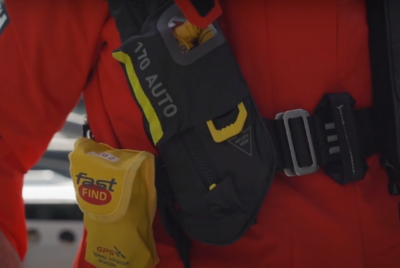
Sailing Apparel: Essential Gear for Smooth Sailing

Sail Boat Trailers: Your Guide to Safe and Convenient Transportation

Sail Boat Decor: Enhancing Your Nautical Oasis

- Find A School
- Certifications
- North U Sail Trim
- Inside Sailing with Peter Isler
- Docking Made Easy
- Study Quizzes
- Bite-sized Lessons
- Fun Quizzes
- Sailing Challenge

Nautical Flags: Origins, Meanings, and Resources
By: Zeke Quezada, ASA Learn To Sail , Nautical Trivia , Sailing History
Nautical flags fly high above anchorages in every popular spot in the Caribbean. Every person who charters a boat has also decided to get a custom burgee to explain that they have arrived. In all honesty, American Sailing has a few nice burgees that I have hoisted, so I am one of those people as well.
However, what do these flags mean, and where did they evolve from?
Nautical Flag Origins and History
Nautical flags have a rich history, and their evolution over time has been fascinating. Nautical flags have been used for centuries to communicate between ships at sea. They are essential tools for sailors to convey important information without the need for modern communication technologies.
The use of flags for communication between ships dates back to the 17th century. Back then, ships would use flags to signal their identities, affiliations, and intentions. Nautical flags were initially used in ancient military encounters to signal actions to other fleet members. In the past, flag communication was limited, and the primary use was to signal the need for a conference where more detailed instructions could be given. The Royal Navy’s Permanent Fighting Instructions, which comprised 45 mixed messages using 11 flags, directly resulted from signals developed during the Anglo-Dutch naval wars of the mid-1700s.
The use of nautical flags evolved, with new flags being introduced to communicate more specific information.
In the 19th century, the International Code of Signals was established to standardize the use of nautical flags. This code uses a combination of signal flags, alphabet flags, and numeral pennants to convey messages. Each flag represents a letter or a number, and the messages are spelled out by stringing together the appropriate flags.
Today, nautical flags are still used for communication between ships, but their use has expanded to include decoration and identification. For example, yacht clubs often use burgee flags to identify themselves, and boats may fly a particular flag to indicate their nationality or affiliation.
Nautical flags come in different shapes, sizes, and colors, each with a specific meaning.
Nautical Flag Uses and Meanings
- Communication – Nautical flags are used to communicate between ships, especially when modern communication technologies are unavailable or have failed. The International Code of Signals is a standardized system that uses nautical flags to communicate messages between ships. This system uses a combination of signal flags, alphabet flags, and numeral pennants to convey messages. Each flag represents a letter or a number, and the messages are spelled out by stringing together the appropriate flags.
- Decoration – Nautical flags are used for decoration, particularly in yacht clubs and marinas. Burgee flags are small triangular flags used to identify a particular yacht club or organization. They are typically flown from the masthead of a yacht or displayed in a prominent location. Many yacht clubs have their unique burgee design, often based on the club’s logo or emblem.
- Identification – Nautical flags are used for identification purposes. For example, the national flag of a particular country is often flown on ships registered in that country. This helps other ships identify the nationality of a particular vessel. Similarly, boats may fly a specific flag to indicate their affiliation or membership in a respective organization or group.
- Competitive Sailing – In competitive sailing, nautical flags communicate information to the sailors. For example, the race committee uses flags to signal the start and finish lines, any changes to the course, and penalties for rule violations. Sailors must understand the meaning of each flag to ensure they comply with the race rules.
- Tradition – Nautical flags are an important part of maritime tradition. For example, the practice of flying a flag at half-mast to honor a shipmate who has died dates back to the 17th century. Similarly, the tradition of saluting a passing ship by dipping your flag or burgee has been a part of nautical culture for centuries
Curious to study more about flags and their meanings?
Check out our Nautical Flags and Knots to Know – Laminated Chart. The ASA laminated flags and knots chart is a handy reference guide for any sailor. 8 1/2″ x 11″ laminated card stock.

Related Posts:

- Learn To Sail
- Mobile Apps
- Online Courses
- Upcoming Courses
- Sailor Resources
- ASA Log Book
- Bite Sized Lessons
- Knots Made Easy
- Catamaran Challenge
- Sailing Vacations
- Sailing Cruises
- Charter Resources
- International Proficiency Certificate
- Find A Charter
- All Articles
- Sailing Tips
- Sailing Terms
- Destinations
- Environmental
- Initiatives
- Instructor Resources
- Become An Instructor
- Become An ASA School
- Member / Instructor Login
- Affiliate Login

Nautical flags: Meanings and Alphabet
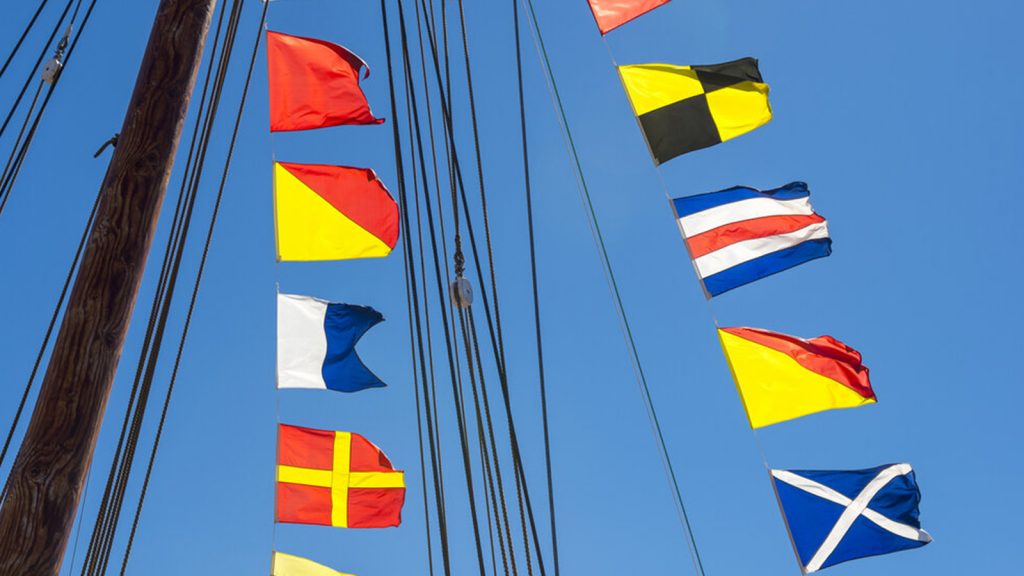
Nautical flags serve the purpose of communication in situations concerning navigation safety and individuals. They form an international code system enabling boats to signal to shore or for two boats to communicate with each other.
Individual flags have specific and standard meanings. These ones can be used in combination with another flag or alone. Using different nautical colored flags have a different meaning.
What are Nautical Flags?
Nautical flags, also known as maritime signal flags, are a set of flags and pennants used to communicate messages between ships and boats. Each flag represents a specific letter, number, or message, allowing vessels to convey information even when verbal communication is not possible.
The use of nautical flags dates back centuries and continues to be an essential aspect of seafaring traditions.
Nautical flags are compose of 26 square flags that represent the letters of the alphabet. There are also 10 numbered pendants, one answering pendant and three substitutes.
You will see nautical flags in a few colors because only a few flag colors are easily recognized:
Nautical Flags and Their Meanings
Importance of nautical flag meanings.
Understanding the meanings behind nautical flags is crucial for anyone involved in maritime activities.
Whether you’re a sailor, a boater, or simply fascinated by the sea, having knowledge of nautical flag communication enables you to interpret messages, navigate safely, and respond appropriately in different situations.
International Code of Signals
The International Code of Signals, also known as ICS, is a special set of rules that tells people who use nautical flags how to use them correctly. It helps sailors understand each other and communicate important messages by using these special flags in a specific way.
It was first established in the 19th century to facilitate communication and prevent misunderstandings among ships of different nationalities.
Over time, the code evolved and expanded to cover a wide range of messages and situations encountered at sea.
Within the International Code of Signals, each nautical flag represents a specific letter or number, as well as a set of predefined messages. These flags are combined to form words, phrases, and sentences, allowing vessels to spell out messages and communicate essential information.
The nautical flags in the International Code of Signals can be categorized into several groups, including alphabetic flags, numeric pennants, substitutes, repeaters, and special flags. Each category serves a specific purpose and carries distinct meanings when used in communication.
Individual Flag Meanings
Numeric pennants and their meanings.
Numeric pennants are a series of flags, each representing a number from zero to nine. These flags are used to communicate numerical information, such as coordinates, distances, or time. By combining different numeric pennants, vessels can convey precise numerical values, ensuring accurate communication between ships.
Letter flags and their meanings
Individual letters of the alphabet are represented by letter flags in the International Code of Signals. They are used to spell words and form sentences. Understanding the meanings assigned to each letter flag is critical for interpreting nautical flag messages and effectively communicating information.
Substitutes and repeaters in nautical flag communication
Substitute flags and repeater flags play important roles in nautical flag communication. Substitute flags are used to replace specific letter flags when they are not available or cannot be easily identified.
Repeater flags, on the other hand, are used to indicate that the preceding flag should be repeated. These flags ensure clarity and facilitate accurate transmission of messages.
Special flags and their purposes
The International Code of Signals includes several special flags that represent specific messages or commands. These flags convey information related to safety, medical assistance, maneuvering instructions, and more.
Understanding the meanings behind these special flags is crucial for maintaining safety and effective communication on the water.
Nautical Flags Meanings
It’s important to understand nautical flags and their meaning because they are valuable at sea in case of breakdowns in other communications systems (eg. radio) or in case of danger.
- One-flag signals are urgent or common signals.
- Two-flag signals are used for distress and maneuvering.
- Three-flag signals are for points of the compass, relative bearings, standard times, verbs, punctuation and also general code and decode signals.
- Four-flags are used mostly for geographical signals, names of ships, bearings, etc.
- Five-flag signals are used to relate time and position.
- Six-flag signals are used to indicate the main cardinal directions (N, S, E or W) in latitude and longitude signals.
- Seven-flags are used as signals for indicating longitude signals containing more than one hundred degrees.
Nautical flags are also used in nautical racing which signal to the competitors what they are supposed to do.
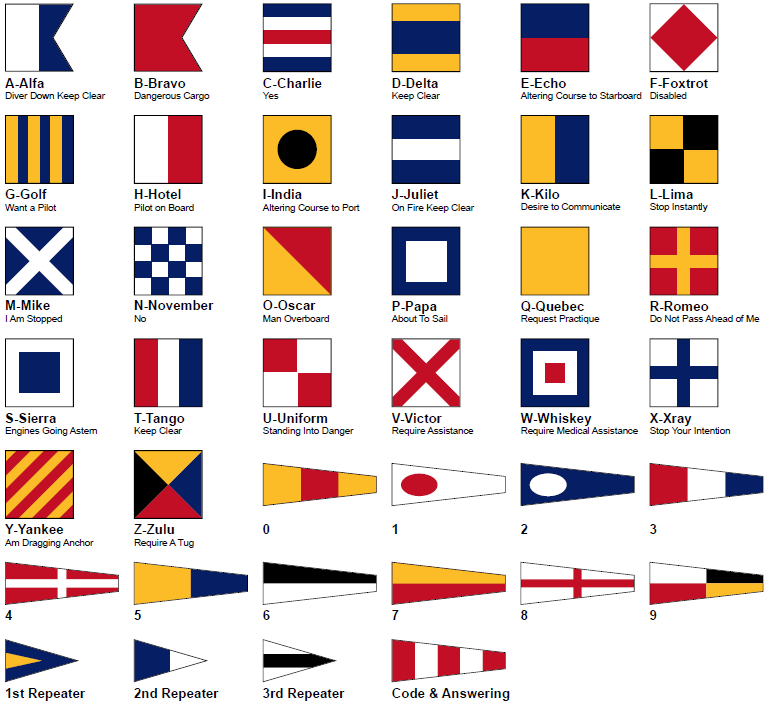
The Nautical Flag Alphabet
It is critical to understand that each flag representing a letter has a specific meaning.
International meanings for nautical flags:
- A: Alpha – diver down; I am undergoing a speed trial
- B: Bravo – carrying dangerous cargo
- C: Charlie – yes (affirmative)
- D: Delta – keep clear of me, I am manoevering with difficulty
- E: Echo – altering course to starboard
- F: Foxtrot – I am disabled, communicate with me
- G: Golf – I want a pilot
- H: Hotel – a pilot on board
- I: India – I am altering my course to port
- J: Juliet – vessel on fire keep clear
- K: Kilo – I want to communicate with you
- L: Lima – stop your vessel instantly, I have something important to communicate; Come Within Hail or Follow Me (Sailing Regatta)
- M: Mike – my vessel is stopped and making no way through the water; Mark Missing (Sailing Regatta)
- N: November – no (negative); Abandonment and Re-sail (Sailing Regatta)
- O: Oscar – Man overboard
- P: Papa – In port: All personnel return to ship; vessel is about to sail; At sea, fishing vessels might use this specific flag to convey the message “My nets have become entangled with an obstacle.”
- Q: Quebec – I request free pratique
- R: Romeo – reverse course
- S: Sierra – engines are going astern
- T: Tango – Keep clear; engaged in trawling. (International); Do not pass ahead of me. (Navy)
- U: Uniform – you are heading into danger
- V: Victor – require assistance
- W: Whiskey – require medical assistance
- X: X-ray – stop your intention
- Y: Yankee – am dragging anchor
- Z: Zulu – I require a tug
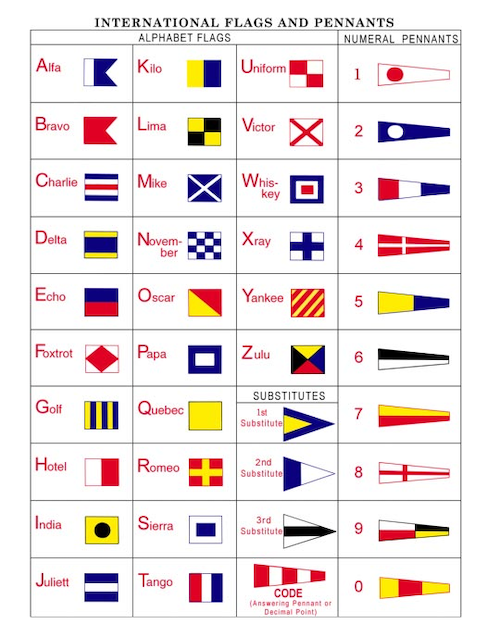
Solo or combined nautical flags have different meanings
Depending on the type of message, boats fly between 1 and 7 nautical flags. The combination of the O (Oscar) and W (Whiskey) flags, meanwhile, means “Man overboard. I require medical assistance”.
Signals with two nautical flags usually mean a certain problem of danger or maneuver. Three or more flags may include pendants and may indicate things such as compass points, time and position, geographic signals, geographic coordinates, and boat names.
Nautical Flags, sometimes the secret language of ships
While sailors around the world use nautical flags to communicate different scenarios, certain situations use secret language.
For example, the US Navy groups signals together in ways known only to its staff to communicate with its fellow ships.
NATO uses also the same nautical flags, with a few additional ones to warships, alone or in short sets to communicate various unclassified messages.
In yacht racing, the nautical flags have other meanings. These ones are solo or combined.
The P flag, for example, is employed as the “preparatory” flag to indicate an impending start, while the S flag indicates that a course has been shortened.
Nautical Flags to Buy
Interested in buying nautical flags to decorate your yacht? Whether you want to add a nautical flag pole, or you’re looking to replace an old nautical flag, we hope you find what you’re looking for!
Set of 50 Nautical Flags
We recommend this set of 50 (100% cotton) nautical flags. All flags are hand-made, so they can be quite smaller or bigger. Each flag is about 8 inches tall and 13 inches wide. All are printed on both sides. They give you a guarantee on color for life.
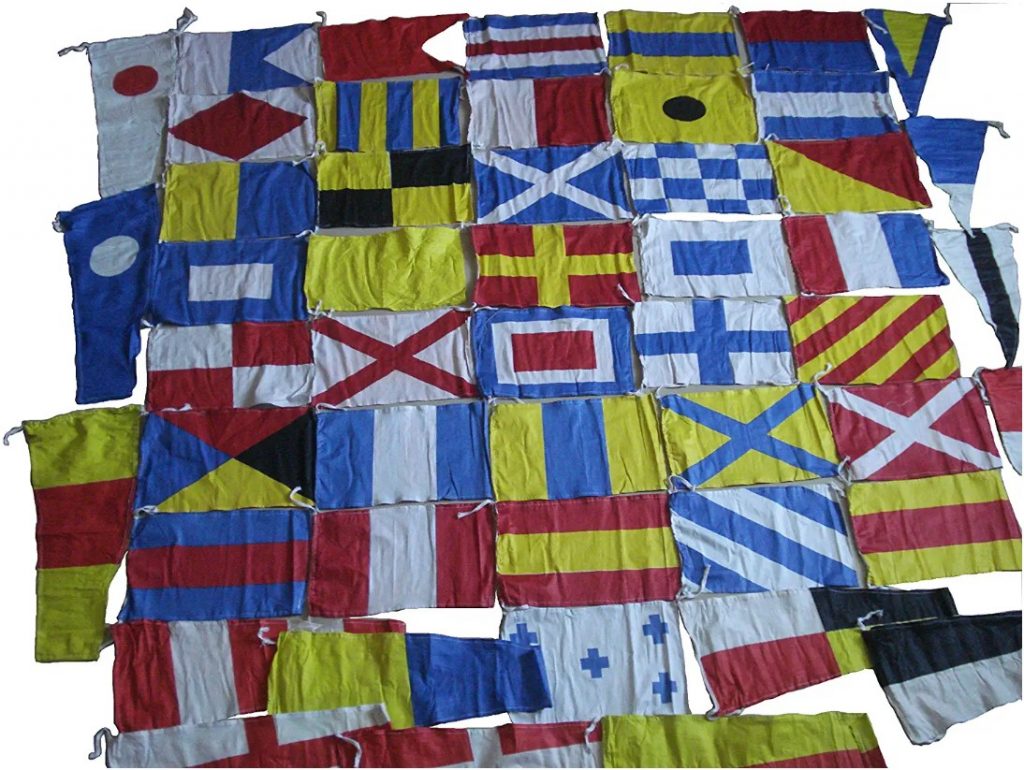
Maritime Signal Flags - 40 Different Decorative Flags - Over 40 Feet Long - Easy to Display
The flags are constructed of weather-resistant nylon cloth with double stitched seams. They are connected on a nylon chain with knots at both ends for convenient hanging.
These rectangular flags are 6″ x 9″, while pennant flags measure 6″ x 14″ or 6″ x 9″. The nylon cable is more than 40 feet long, with 7″ between flags and 36″ ties on either end.
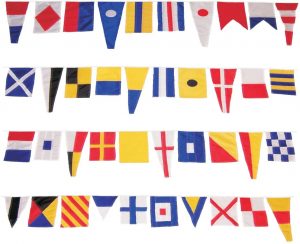
FLAGLINK International Marine Navy Signal Code Flag Set - String of 40 Flag - 40 Feet Long – Nautical Maritime Boat Ship Vessel Nautical Theme Decoration for Patry
Do you plan on throwing a big party on the boat and want to deck out the entire vessel in honor of the occasion? These nautical flags, which are less expensive than the previous ones, are an excellent choice for interior or outdoor decorations.
You may hang your ornamental flags in your front yard, garden, or patio, so that your family and friends can view the gorgeous holiday flag design from every aspect and vantage point. Because they are constructed of a water-resistant polyester fabric, they may be left outside for an extended period of time.
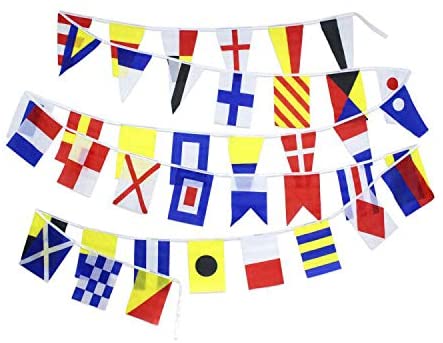
What nautical flags mean?
The purpose of nautical flags is to give ways and means of communication in circumstances involving the safety of navigation and people. Nautical flags are an international coding system used for a boat to indicate to land or for two vessels to signal to each other in situations involving the safety of navigation and people.
How many nautical flags are there?
There are 26 square nautical flags. Each of them symbolizes an international code term associated with the letters of the alphabet, such as Alpha, Bravo, Charlie, Delta, and so on.
What are nautical flags called?
Nautical flags are also known as international maritime signal flags, signal flags or boat flags.
How do you spell out messages using nautical flags?
Messages are spelled out using nautical flags by hoisting the flags in the correct sequence according to the International Code of Signals. Each flag represents a letter, and the combination of flags creates words, phrases, and sentences.
Are there any alternative systems to nautical flag communication?
While nautical flags are widely used for communication at sea, alternative systems such as radio communication, semaphore flags, and modern technologies like VHF radios and satellite communications also play a role in maritime communication.
Where can I learn more about nautical flag meanings?
To learn more about nautical flag meanings and communication, you can refer to resources such as official publications on the International Code of Signals, maritime museums, boating and sailing organizations, and online references that provide detailed information on nautical flags and their meanings.
Leave a Comment Cancel Reply
Your email address will not be published. Required fields are marked *
Decoding Yacht Flags and Symbols: A Guide to Nautical Communication
- by yachtman
- October 5, 2023 September 20, 2023
Nautical communication plays a crucial role in the maritime environment, ensuring efficient and effective communication between vessels. Understanding the various flags and symbols used in this system is essential for all seafarers. In this guide, we will decode yacht flags and symbols , providing a comprehensive understanding of nautical communication.
The purpose of nautical communication is to convey important information, such as navigational instructions, warnings, distress signals, and identification between vessels. Strong communication protocols are vital in preventing accidents, coordinating navigation, and maintaining safety at sea.
The International Code of Signals (ICS) is a standardized system used for nautical communication worldwide. This code consists of various flags and symbols that represent specific messages. It allows vessels from different countries to communicate effectively, regardless of language barriers.
Understanding yacht flags is a fundamental aspect of nautical communication. Yacht flags are used to convey specific messages or indicate the vessel’s status, intentions, or requests. These flags come in various types, including national flags, signal flags, courtesy flags, and special flags representing different meanings.
In addition to flags, nautical communication also involves the use of symbols. These symbols are graphical representations used to convey information quickly and efficiently. They are commonly used in charts, maps, and other navigational aids to indicate hazards, buoys, or specific instructions.
Decoding yacht flag combinations is crucial for understanding the message being communicated. Different combinations of flags can convey various meanings, including identification of vessels, communication of navigational instructions, or indication of distress situations.
Certain yacht flag combinations are commonly used in specific situations or to convey specific messages. Recognizing these commonly used combinations is essential for all seafarers to ensure effective communication and safe navigation.
Yacht flags are also used for distress signals , indicating that a vessel is in immediate danger and requires assistance. Understanding how to use these flags properly can potentially save lives and ensure prompt response during emergencies.
To ensure effective nautical communication, it is important to follow best practices. This includes proper understanding and utilization of the International Code of Signals, maintaining clear and concise communication protocols, and adhering to international maritime regulations.
By decoding yacht flags and symbols and understanding their implications, seafarers can enhance their communication skills and contribute to safer and more efficient navigation in the maritime environment.
Key takeaway:
- Understanding yacht flags and symbols facilitates effective nautical communication: Familiarity with yacht flags and symbols enables sailors to convey messages and communicate important information on the water.
- International Code of Signals: The International Code of Signals serves as a standardized system for communication among maritime vessels, ensuring clear and consistent understanding between sailors.
- Proper use of yacht flags can signal distress: Yacht flags can be used as distress signals, allowing sailors to communicate the need for assistance in emergency situations.
The Purpose of Nautical Communication
Nautical communication serves the purpose of ensuring safety, facilitating navigation, coordinating activities, exchanging information, and complying with regulations in the maritime industry. The primary purpose of nautical communication is to ensure the safety of vessels at sea. It allows ships to exchange vital information such as their positions, courses, and speeds, which helps in preventing collisions. For example, by using visual signals like flags or lights, ships can indicate their intentions and avoid potential accidents.
Nautical communication also facilitates effective navigation by providing information about navigational hazards, such as shallow waters or wrecks. This information is crucial for mariners to plan their routes and avoid potential dangers. VHF radio communication is particularly important in relaying real-time updates and warnings to mariners.
Furthermore, communication enables coordination and cooperation among different vessels and maritime authorities. It allows ships to request assistance during emergencies or distress situations, enabling prompt search and rescue operations. It also helps to coordinate activities such as docking, pilotage, and navigation in crowded port areas.
Moreover, nautical communication helps in exchanging important information related to weather conditions , berthing availability , port protocols , and other relevant updates. This information ensures efficient and smooth operations, minimizing delays, and maximizing productivity.
Finally, effective communication is necessary to comply with international maritime regulations and laws . Ships need to communicate with port authorities, coast guards, and other relevant bodies to fulfill reporting requirements and obtain necessary clearances.
By maintaining clear and effective communication, the maritime community can operate safely and efficiently at sea.
As you explore the world of nautical communication, remember to familiarize yourself with the different flag signals, radio procedures, and other communication methods to enhance your understanding and promote safe and smooth sailing.
Why is Communication Important in the Maritime Environment?
Communication is of utmost importance in the maritime environment. In a setting where safety is paramount and distances are vast, effective communication plays a crucial role in avoiding accidents, ensuring smooth operations, and saving lives.
One notable example of the importance of communication in the maritime environment is the story of the Titanic . The tragic sinking of the Titanic in 1912 was partly attributed to communication failures. Despite receiving multiple warnings of icebergs in the area, the crew failed to relay this crucial information to the bridge in a timely manner. This lack of effective communication contributed to the collision and subsequent sinking of the ship. The Titanic serves as a stark reminder of the vital role that communication plays in ensuring the safety and success of maritime operations.
The International Code of Signals
Below is a table highlighting some aspects of the International Code of Signals:
Fact: The International Code of Signals was first published in 1887 and has since undergone several revisions to accommodate new technologies and improve communication between vessels.
What is the International Code of Signals?
The International Code of Signals, also known as the “ International Code of Signals “, is a set of signals used in maritime communication. It serves as a universal language at sea, allowing for efficient and effective communication between vessels of different nationalities. This internationally recognized system enables ships and other vessels to convey important information related to navigation, safety, and emergencies.
The code consists of a combination of flags, pennants, and symbols that represent specific letters, numbers, and phrases. Each flag or symbol has a unique meaning, ensuring clear and concise communication between vessels. By using this standardized system, mariners can communicate essential information without the need for verbal language or misunderstandings. For instance, they can signal their intention to change course, request assistance, or indicate a potential danger ahead.
The International Code of Signals is particularly crucial in emergency situations where quick and accurate communication is vital. Distress signals, which are part of the code, are used to indicate that a vessel is in need of immediate assistance. Understanding and being able to interpret this code is essential for anyone involved in maritime operations , as it ensures smooth and safe communication between vessels, thereby enhancing overall safety and efficiency.
How is the International Code of Signals Used?
The International Code of Signals is a crucial system used in nautical communication . Here’s how the International Code of Signals is used:
Understanding how the International Code of Signals is used is essential for effective nautical communication and maintaining safety at sea. By following the standardized protocols and using the correct flags and signals, vessels can ensure clear and accurate communication with other ships and shore authorities.
Understanding Yacht Flags and Symbols
It is crucial to have a comprehensive understanding of yacht flags and symbols for effective nautical communication. By acquiring knowledge about these visual signals, yacht captains and crew members can easily convey important messages to other vessels on the water. To assist with this, a table below provides an overview of common yacht flags and their meanings:
Having a solid grasp of these yacht flags and symbols is essential for effective communication on the water. Yacht captains and crew members can quickly and accurately send and receive messages, ensuring the safety and smooth operation of their vessels. By familiarizing oneself with these symbols, individuals can navigate the waters confidently and adhere to proper maritime protocol.
What are Yacht Flags?
What are Yacht Flags ?
Yacht flags are an essential part of nautical communication, serving various purposes and conveying important messages. To understand yacht flags better, here is a list of key information:
1. Yacht flags, also known as pennants , are specially designed flags that are used to communicate messages between vessels or to convey important information to others on the water.
2. These flags are typically made of durable materials and are designed to be easily visible from a distance, ensuring effective communication on the open sea.
3. Yacht flags come in different colors, shapes, and patterns, each representing a specific message or information. For example, the yellow “ Q ” flag signifies quarantine, while the red and white checkered flag signifies a diver in the water.
4. Yacht flags are categorized into different types, including national flags, signal flags, storm flags, courtesy flags, and burgee flags. Each type has its own significance and purpose.
5. Signal flags, which are also known as alphabet flags , are used to spell out messages or convey specific meanings using letters or combinations of letters.
6. Yacht flags often incorporate symbols that represent specific nautical messages. For instance, the “B” flag with a white diagonal stripe signifies “I am taking in or discharging or carrying dangerous goods.”
7. It is important for sailors and boat owners to familiarize themselves with the meanings and uses of different yacht flags to ensure clear and effective communication while out at sea.
8. Knowing the proper usage of yacht flags can promote safety, prevent misunderstandings, and facilitate smooth navigation and interaction among vessels.
Fact: Did you know that the International Maritime Organization (IMO) regulates the use of yacht flags? This ensures standardized communication between vessels worldwide and enhances safety in the maritime environment.
What are the Different Types of Yacht Flags?
These are just a few examples of the different types of yacht flags that are commonly used in nautical communication. Each flag has a specific meaning and is used to convey important information between vessels. Understanding these flags is crucial for maintaining safe and effective communication at sea.
Yacht flags play a vital role in nautical communication. They serve as a visual means of conveying important messages between vessels. By understanding the different types of yacht flags and their meanings, sailors can ensure safe and efficient communication on the water. It is important to always abide by the proper usage and meaning of each flag to ensure clear and effective communication between vessels.
What Symbols are Used in Nautical Communication?
Nautical communication relies on various symbols to convey important messages at sea. These symbols serve as a universal language for maritime communication, allowing sailors and boaters from different countries to understand each other. To understand the symbols used in nautical communication, refer to the table below:
These symbols are just a few examples of the many that exist in nautical communication. Each symbol has a specific meaning and can be easily identified by experienced sailors. Understanding these symbols is crucial for safe navigation and effective communication on the water.
Now, let me share a true story that highlights the importance of these symbols in nautical communication. A few years ago, a small sailing vessel encountered a strong storm while at sea. The crew urgently needed assistance, but due to the heavy rain and rough conditions, radio communication was impossible. They were able to use nautical flags to signal distress to a passing cargo ship. The crew on the cargo ship recognized the distress signal and swiftly came to their aid, ensuring their safety. This incident demonstrates the critical role that symbols play in nautical communication, allowing for effective communication even in challenging situations.
By familiarizing yourself with the symbols used in nautical communication, you can enhance your safety at sea and ensure smooth and efficient communication with other boaters and vessels.
Decoding Yacht Flag Combinations
Decoding Yacht Flag Combinations can provide crucial information about the actions or situations occurring on a yacht. By understanding the meaning behind a specific flag combination, you can ensure safety and effective communication on the water. Here are some common yacht flag combinations and their corresponding meanings:
Charlie + Yankee : Diving operations underway; keep clear.
Delta + Sierra : Keep clear, engaged in towing.
Lima + Mike : Vessel is not under command; maneuverability is impaired.
Oscar + Papa : Man overboard.
Quebec + Romeo + Zulu : Require medical assistance.
Victor + Zulu + Lima: Require assistance; request help immediately.
By familiarizing yourself with these flag combinations, you can quickly interpret the messages being conveyed and respond accordingly. This knowledge can be invaluable in situations where prompt action is necessary for the safety and well-being of those on board.
In addition to understanding these flag combinations, it is crucial to stay updated on any changes or additions to the International Code of Signals. This ensures that you are aware of any newly assigned meanings or alterations to existing combinations.
Fact : The International Code of Signals was first published in 1857 to establish a standardized system of communication for maritime use.
Commonly Used Yacht Flag Combinations
The commonly used yacht flag combinations are crucial for effective nautical communication. A reference table of these combinations is provided below:
These are just a few examples of the commonly used yacht flag combinations. Understanding and appropriately responding to these signals is essential for maintaining safety and effective communication on the water.
To ensure safe and efficient navigation, it is recommended that all boaters familiarize themselves with the meanings of the different flag combinations. Proper flag etiquette should be followed, including displaying the flags in the correct order and in good condition.
By being knowledgeable and respectful of these commonly used yacht flag combinations, boaters can enhance overall safety and avoid miscommunication while enjoying their time on the water.
Using Yacht Flags for Distress Signals
- When facing a distress situation at sea, it is crucial to know how to use yacht flags for distress signals. By using yacht flags for distress signals , you can communicate your need for assistance and ensure that help is on the way. Here is a guide to using yacht flags for distress signals:
- Raise the “ NC ” flag (November Charlie) upside down. This flag indicates that you are in distress and require immediate assistance.
- If you have a second mast, hoist the flag “ YY ” (Yankee Yankee) upside down alongside the “NC” flag. This indicates that you are unable to navigate.
- If you are unable to raise the flags due to a disabled mast, use a black circle on a yellow background flag (Oscar) to indicate distress.
- In daylight, use distress smoke signals to attract attention. Orange smoke signals can be used to indicate your location and need for assistance.
- If you have access to a radio transmitter, use the international distress signal “ MAYDAY ” to communicate your distress situation and coordinates to the nearest authorities.
Remember, every moment counts in a distress situation. Ensure that all crew members are aware of the correct distress signals and take immediate action to signal for help.
If you encounter a vessel displaying distress signals, it is your duty as a fellow seafarer to provide assistance if it is safe to do so. Always prioritize the safety of your crew and vessel while extending aid to those in distress.
By understanding and using yacht flags for distress signals, you can effectively communicate your need for help and increase the chances of a swift and successful rescue.
Best Practices for Nautical Communication
When it comes to nautical communication, incorporating best practices is crucial for ensuring clear and effective communication on the water. By following these guidelines, you can ensure that your messages are conveyed in a way that is understood by others.
By incorporating these best practices for nautical communication, you can ensure that your communication on the water is effective and efficient. This will lead to a safer and more enjoyable experience for everyone involved.
Some Facts About Decoding Yacht Flags and Symbols: A Guide to Nautical Communication:
- ✅ Nautical flags, also known as burgees, have a rich history and were originally used in ancient military encounters to communicate with other fleet members. (Source: Shorelines Illustrated)
- ✅ Code signal flags are part of an internationally-understood system that includes 26 square flags representing letters of the alphabet, numeral pendants, and other symbols. (Source: Shorelines Illustrated)
- ✅ The primary colors of red, blue, yellow, black, and white were chosen for visibility at sea, and the flags are designed to have high contrast. (Source: Shorelines Illustrated)
- ✅ Nautical boating flags are used to identify vessels, with the three most commonly used flags being the national ensign, the yacht club burgee, and a private signal. (Source: Shorelines Illustrated)
- ✅ Boat flags are nautical flags used to convey messages from ship to ship or ship to shore. Each flag has a different meaning and can be used alone or in a group. (Source: Vispronet)
Frequently Asked Questions
How are colored flags used for urgent messages in nautical communication.
Colored flags are used to convey urgent messages in nautical communication. In the internationally-understood system of code signal flags, the primary colors of red, blue, yellow, black, and white are chosen for high visibility at sea. These flags are designed to have high contrast and are used to indicate various urgent situations or maneuvers between vessels.
What are numeral pendants and how are they used in nautical communication?
Numeral pendants are part of the code signal flags, which are used in nautical communication. These pendants represent numerical information and can be used to convey specific numeric messages between ships or ship to shore. They are a key component of the internationally-understood system of code signals that allows for efficient communication in maritime activities.
How does the international code system facilitate communication between different foreign governments during maritime activities?
The international code system, represented by code signal flags, plays a crucial role in facilitating communication between different foreign governments during maritime activities. Each letter of the alphabet is represented by a specific flag, allowing for a standardized code that can be easily understood by vessels from various nations. This system enables efficient communication and promotes safety and coordination on the open water.
What is the significance of flag communication in ship to shore communication?
Flag communication, using nautical flags, holds great significance in ship to shore communication. It provides a reliable and visible method of communication, even in situations where electronic navigation or verbal communication may not be possible. By using code signal flags and other nautical flags, vessels can convey important messages to shore authorities or receive instructions when communication breakdown occurs.
How are flag meanings determined for yacht racing in international waters?
Flag meanings for yacht racing in international waters are determined based on the internationally-understood system of code signal flags and other specialized flags. These flags, such as the yacht club burgee and private signal, represent specific messages or identification for the participating vessels. The use of these standardized flag meanings ensures fair competition and effective communication between racing yachts in international waters.
Can you provide examples of how nautical flags are used for geographical signals and points of the compass?
Absolutely! Nautical flags are used to convey geographical signals and points of the compass. For example, the “P” flag represents geographical signals and is used to indicate that a vessel requires a pilot. Additionally, specific flag combinations are used to indicate particular points of the compass, enabling vessels to communicate their heading or intended direction to passing vessels or shore authorities.
Leave a Reply Cancel reply
Your email address will not be published. Required fields are marked *
Save my name, email, and website in this browser for the next time I comment.

Nautical flags and meanings
- No Comments

Welcome to the intriguing world of nautical flags! Seafarers have used nautical flags for generations to communicate. Each flag symbolizes a letter or message with its own design and color scheme. These flags carry vital information including distress signals, identity, and directions in marine communication. Nautical flags are fun to learn about whether you’re a sailor or a landlubber. To help you decipher the sea’s hidden language, we’ll introduce you to some of the most essential and often-used nautical flags.

A: Alpha – Diver down (Small diving vessel); keep clear
Check this video quiz ↗

B: Bravo – Carrying dangerous cargo

C: Charlie – Yes (affirmative)
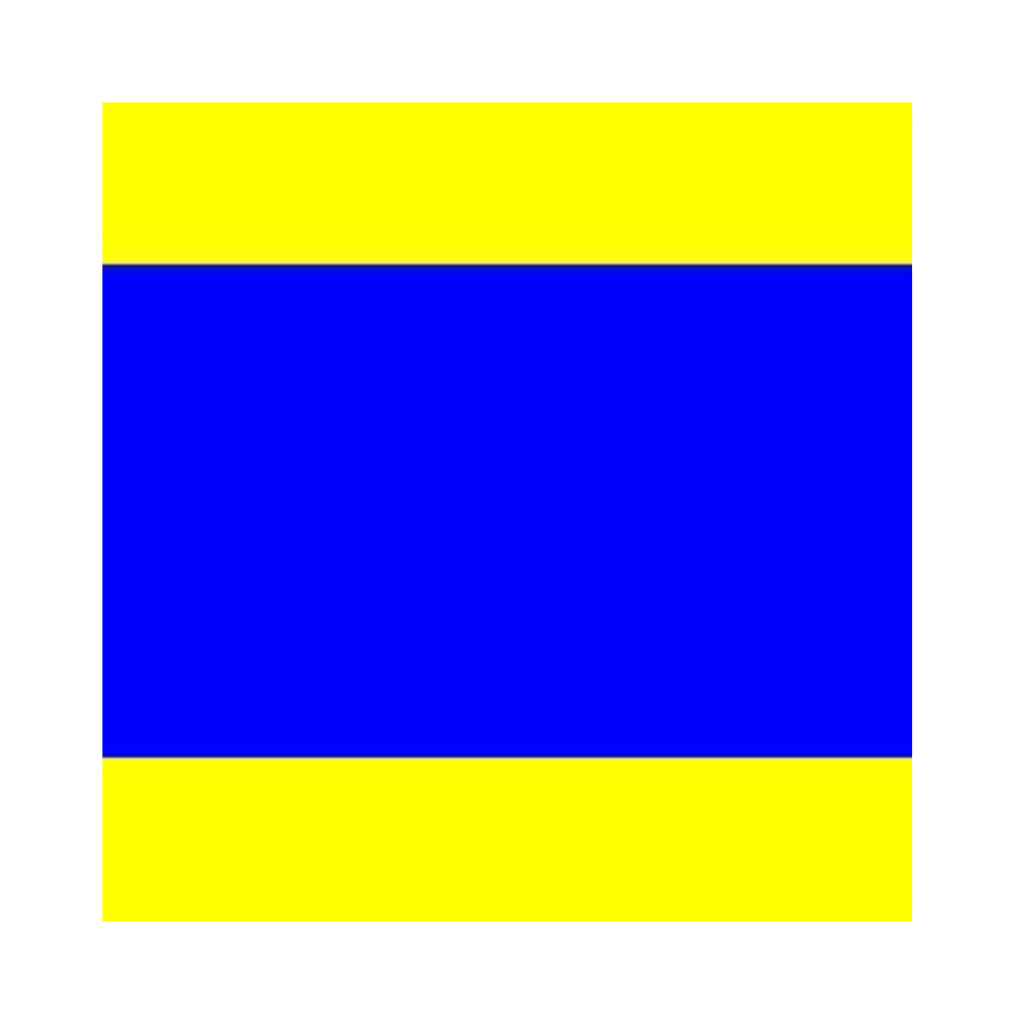
D: Delta – Keep clear of me, I am maneuvering with difficulty

E: Echo – Altering course to starboard

F: Foxtrot – I am disabled, communicate with me

G: Golf – I want a pilot
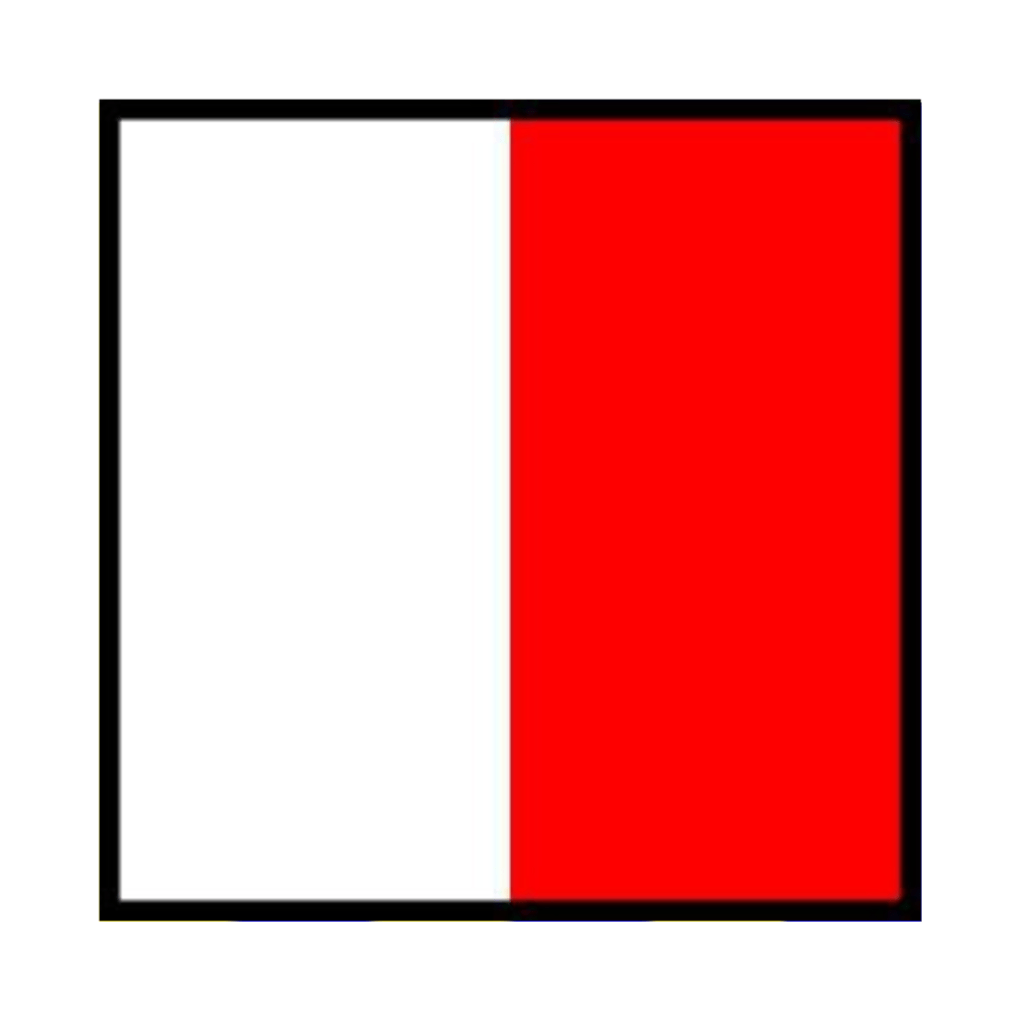
H: Hotel – A pilot on board

I: India – I am altering my course to port

J: Juliet – A vessel on fire, keep clear
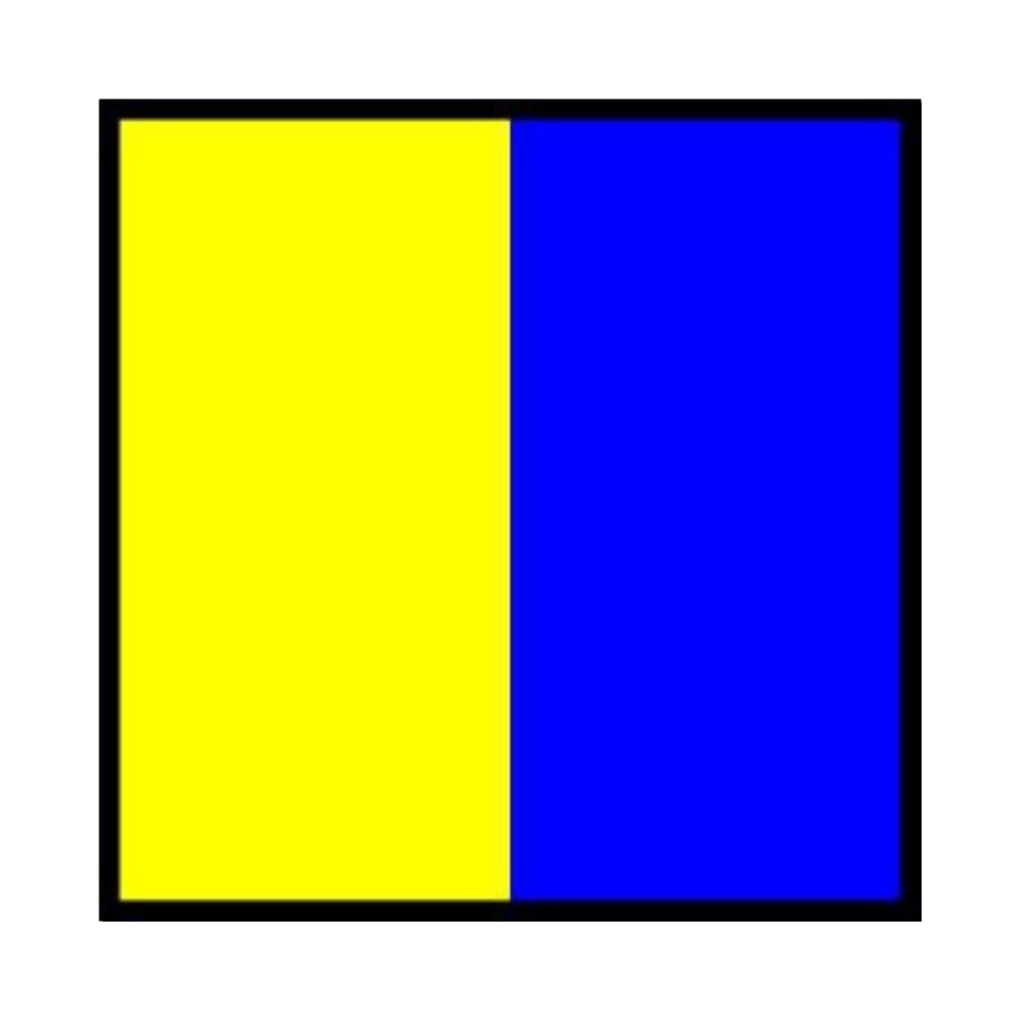
K: Kilo – I want to communicate with you
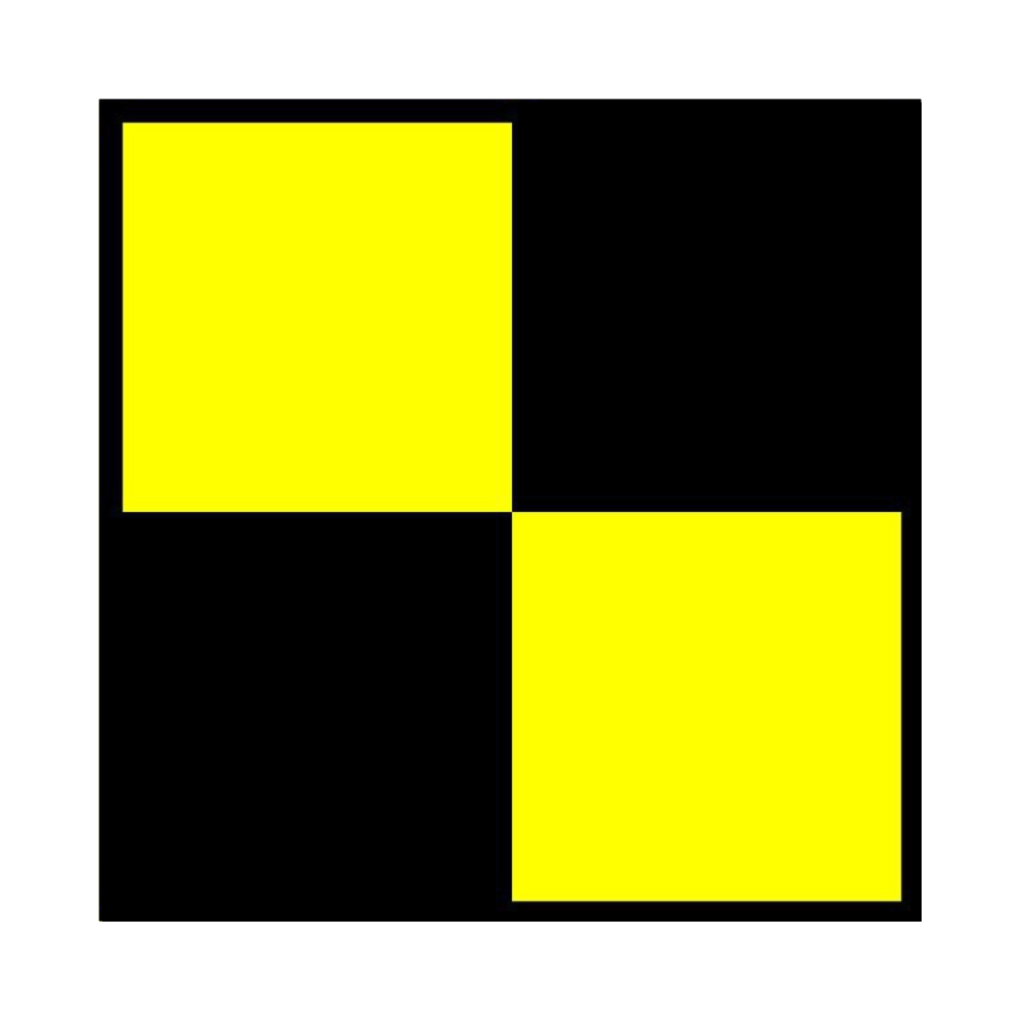
L: Lima – Sop your vessel instantly, I have something important to communicate; Come Within Hail or Follow Me (Sailing Regatta)

M: Mike – My vessel is stopped

N: November – No (negative)

O: Oscar – Man overboard

P: Papa – In port: All personnel return to the ship; the vessel is about to sail; At sea: It may be used by fishing vessels to mean: “My nets have come fast upon an obstruction”

Q: Quebec – I request free pratique

R: Romeo – Reverse Course

S: Sierra – Engines are going astern
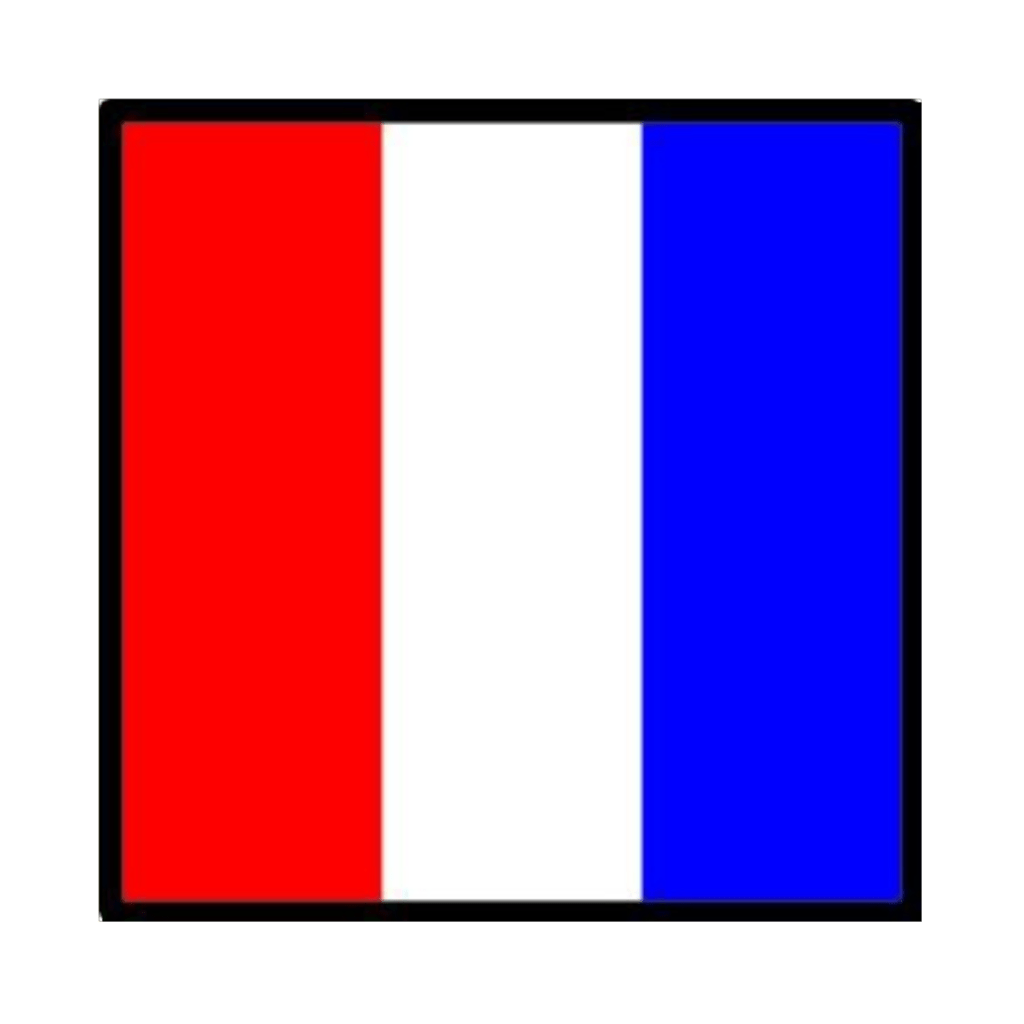
T: Tango – Keep clear; engaged in trawling (International); Do not pass ahead of me (Navy)

U: Uniform – You are heading into danger
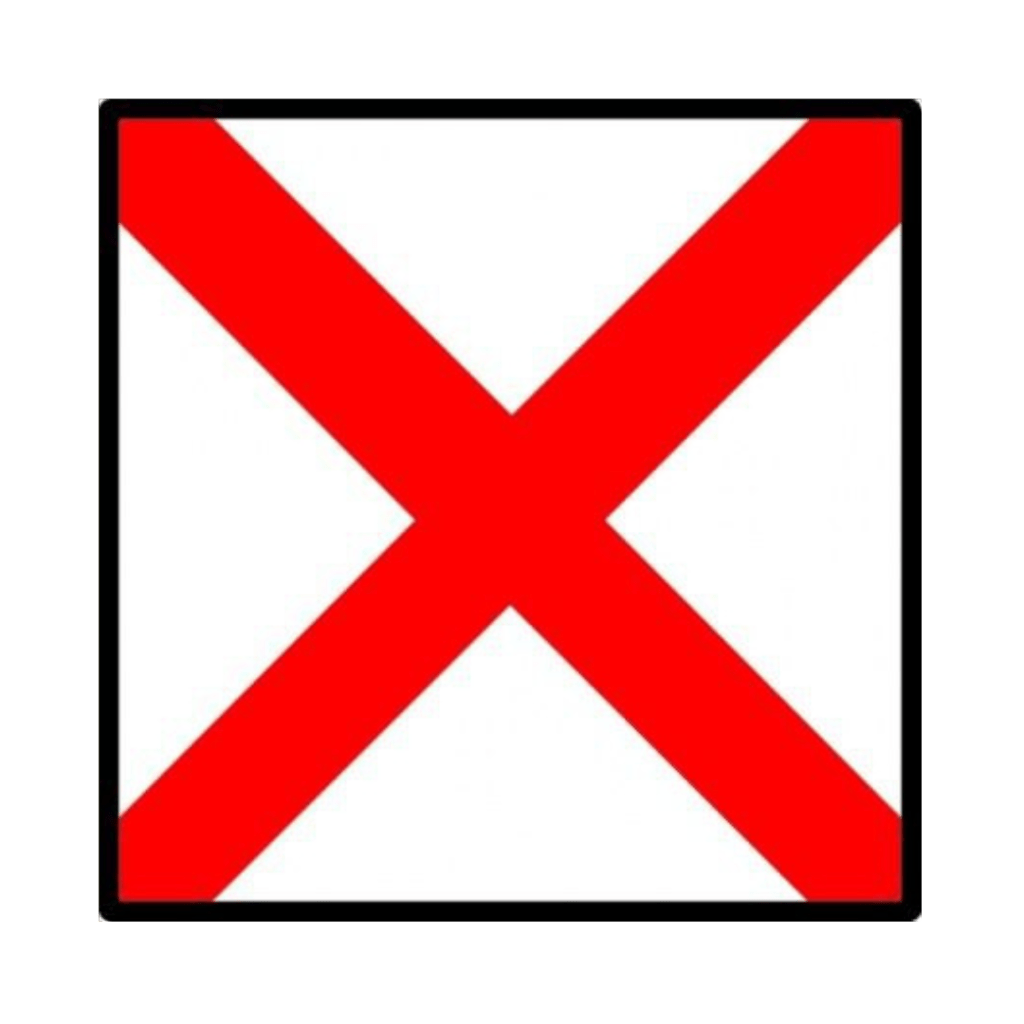
V: Victor – Require assistance

W: Whiskey – Require medical assistance

X: X-ray – Stop your intention

Y: Yankee – Am dragging anchor

Z: Zulu – I require a tug

▶ Follow Sailing Click on Youtube!
Yacht flags play an essential role in sailing, navigation, and communication among sailors. These flags are a part of the nautical flags category and are also known as nautical signal flags or sailing flags. Each flag has a specific meaning, and it is important for sailors to know them to communicate effectively and safely.
Nautical flags have been used for centuries to communicate messages between ships, and today they are still an important part of maritime tradition. Yacht flags are used for a variety of purposes, from signaling the vessel’s nationality to indicating its sailing status.
The International Code of Signals governs the use of nautical flags and sets out specific rules for their use. The code includes 26 alphabetical flags, 10 numerical pennants, and 3 substitute flags that are used to represent letters that are not included in the alphabet.
Yacht flags , in particular, are used to signal the boat’s identity, status, or intention. For example, a yellow and blue flag with a white anchor in the center is a signal for a vessel that is at anchor. A white flag with a blue square and a white cross in the center signals that the boat is a medical vessel or has a medical emergency on board.
Other popular yacht flags include the burgee, which is a triangular flag that represents the boat’s club or organization, and the courtesy flag, which is flown to show respect for the host country’s flag when sailing in foreign waters. The courtesy flag is often flown on the starboard spreader of the boat.
Navigation flags are another type of yacht flag used for signaling a boat’s movements or intentions. These flags are often used in racing or in other situations where it is important to communicate quickly and clearly. For example, a blue flag with a white diagonal stripe indicates that the boat is tacking, while a yellow and black flag signals that the boat is approaching a mark.
In addition to their practical uses, yacht flags are also an important part of maritime tradition and are often used for decorative purposes. Many sailors display their yacht flags on board their boats as a way of showing off their sailing accomplishments or their affiliation with a particular club or organization.
In conclusion, yacht flags are an important part of sailing and navigation, serving practical and decorative purposes. Knowing the meaning of each flag is crucial for effective communication and safety while on the water. So, next time you see a yacht flag waving in the wind, take a moment to appreciate the rich history and tradition behind it.
Leave a Review Cancel reply
You must be logged in to post a comment.
You may also like
Sailing spots.

Where is the best place to rent a boat in Europe? Top 5 questions.

Australian Marine Life: A Yachter’s Guide to Beauty and Safety
Yachting basics.

Understanding and Using the Points of Sail: A Comprehensive Guide

Yacht Anodes: Everything You Need to Know
Sailing routes.

Sailing Route from Split, Croatia: A Seven-Day Itinerary for Beginners

Sailing Route in the Bahamas
Yacht events.
No listings were found matching your selection. Something missing? Why not add a listing? .
Sailing News

Lahaina Harbor Engulfed: Hawaii’s Fiery Catastrophe

Celebrating the New Year on a Chartered Sailing Yacht
Faces in yachting.

John F. Kennedy: The Yachtsman President

Unforgettable Journeys: The Legendary Adventures of Sir Francis Chichester
Boat reviews.

- TOP Charter Deals (updated)
- Advertising and Promotion
- Privacy Policy
- Cookie Policy
Please note that some links on our site are affiliate links. This means we may earn a commission at no extra cost to you if you click on them and make a purchase. We recommend products because we believe they add value, not because of the commission we receive. Your support helps keep our site running. If you have questions, please reach out to us.
Privacy Overview
Change location, find awesome listings near you.
- Gift Certificate
- --> Login or Sign Up

Shop by Category
- Air Quality
- All Accessories
- License Plates and Frames
- Decals/Pins/Patches
- All Advertising
- Automotive/Dealership
- Message Flags
- Solid and Checkered
- All Auto/Bike/Boat
- Bike/Motorcycle Flags
- Car/ Motorcycle Racing
- Dealership Car Flags
- Classroom/ School
- All Commercial
- Advertising & Message
- Rope & Snaphooks
- External Halyard Parts
- Internal Halyard Parts
- All Feather Flags and Hardware
- Delivery / Take Out
- Auto Services
- Cigar Cigarettes
- Electronics
- Farmers Market
- Garden Center
- Hardware Store
- Marijuana Stores
- Miscellaneous
- Real Estate
- Semi Custom Flags
- Tax Services
- Wine, Beer and Liquor
- All Flagpoles/Parts/Rope
- Residential Poles, Parts & Rope
- Repair and Service
- All Government Depts
- Central Intelligence Agency
- Defense Logistics Agency
- Federal Deposit Insurance Corporation (FDIC)
- Missile Defense Agency
- National Credit Union Administration
- Office of the President
- U.S. Agency for International Development
- United States Securities and Exchange Commission
- Peace Corps
- Federal Trade Commission
- Small Business Administration (SBA)
- National Transportation Safety Board (NTSB)
- United States Supreme Court
- Dept of Agriculture
- Dept of Commerce
- Dept of Defense
- Dept of Education
- Dept of Energy
- Dept of Health & Human Services
- Dept of Homeland Security
- Dept of Housing & Urban Development
- Dept of Justice
- Dept of Labor
- Dept of State
- Dept of Transportation
- Dept of the Treasury
- Dept of the Interior
- Dept of Veterans Affairs
- Dir of National Intelligence
- Environmental Protection
- Federal Bureau of Investigation
- Federal Reserve System
- General Services Administration
- Government Accountability Office
- Office of Personnel Management
- Social Security Administration
- The Smithsonian Institution
- U.S. Civil Service
- U.S. Defense Heath Agency
- U.S. Defense Threat Reduction Agency
- U.S. Congress
- U.S. Postal Service
- U.S. Strategic Command
- All Grave Markers
- Grave Markers - 3 Inch Medallions
- Grave Markers - 6 Inch w/rod and no rod
- All Indoor/Parade/Lobby
- Indoor Flag Sets
- Ceremonial Poles
- Floor Bases
- Ornaments and Finials
- Parade/Banner Poles
- Cord & Tassels
- Flag Covers
- All International Flags
- International
- International Stick Flags
- All Military
- Military Indoor Lobby Sets
- U.S. Air Force - Air National Guard
- U.S. Army National Guard
- U.S. Air Force
- U.S. Marine Corps
- U.S. Coast Guard
- U.S. Space Force
- U.S. Merchant Marine
- U.S. POW / MIA
- Blue Star Service Banners
- Gold Star Service Banners
- U.S. Military Service & Support
- U.S. Military Accessories
- All Nautical
- Code of Signals
- Beach Warnings
- Coast Guard
- Foreign 12x18 Inch
- Power Boat Racing Flags
- Semaphore Signal Flags
- Skin Diving
- State 12x18 Inches
- Shark Warnings
- Yacht Ensign
- All String Pennants
- Regular Solids
- Icicle Solids
- Fluorescent Regular & Icicle
- Pride / Rainbow
- All Police/Fire/EMS
- All Religious
- Denominational
- Denominational Lobby Sets
- All Residential
- Residential House Poles
- Seasonal and Theme
- Brackets & Holders
- Parts & Accessories
- Solar Lights
- In-Ground Flagpoles
- Memphis Grizzlies
- Univ Alabama
- Univ Arkansas
- Univ Mississippi
- Mississippi State University
- Univ Memphis
- Univ Tennessee
- Solid Colors and Checkered
- All Specialty Flags
- Memphis in May
- Mississippi
- Confederate
- All States/Cities
- All Stick Flags and Sets
- Stick Flag Base
- State Stick Flags
- Military Stick Flags
- Specialty & Novelty Stick Flags
- Miscellaneous Flag Sets
- All US Flags/Patriotic
- US Flags by Size
- US Polyester Flags
- US Nylon Flags
- US Cotton Flags
- US Indoor and Lobby Flags
- US G'Spec Flags
- Fire Truck Flags
- US Hanger & Warehouse Flags
- US Auto, Bike and Boat Flags
- US Pins, Decals and Accessories
- US Stick Flags
- Patriotic Decorations
- All U.S. Stick Flags
Shop by Brand
- Global Advertising
- Annin Flagmakers
- National Banner
- Eagle Emblems
- Valley Forge
- Magnolia Garden
- View all Brands
- CenTec Cast Metal Products
- BSI Products
- Temple Aluminum Foundry
- Sewing Concepts
- Spartacraft
- In The Breeze
- Two Group Flag
- Atlas Flags
- Flag Source
- U.S. Flag Maker
- American Plaque

Racing Flag Signals
Sail races are governed with flags and sound signals to indicate flag changes. The flags used are taken from the International maritime signal flag set. During a race and for any signal concerning the race, these flags are defined in the ISAF Racing Rules of Sailing but the signal can be modified by the Sailing Instructions.
The raising (hoisting) or removing of a visual signal is accompanied by the emission of a sound signal to draw attention to the new signal. The type of the sound signal (one short sound, two short sounds, one long sound, etc.) is described by the rule according to the type of signal.
Click here for a link to "Racing Rules Of Sailing" and usual meanings of racing flags.

Race Committee Flag - 20x30 Inches

Race Committee Flag - 24x36 Inches
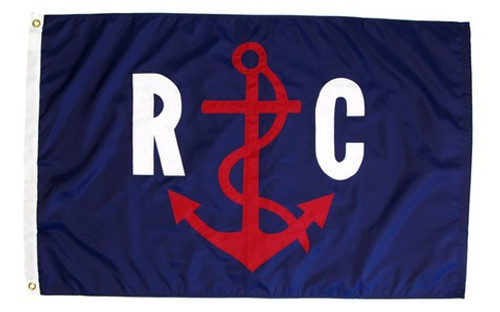
Race Committee Flag - 12x18 Inches
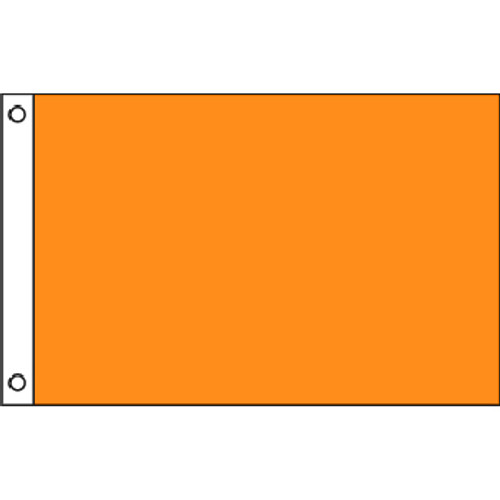
On Station Flag
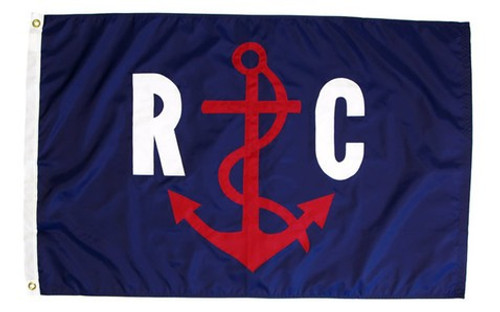
Race Committee Flag

Black & White 2x3 Foot Checkered Flag
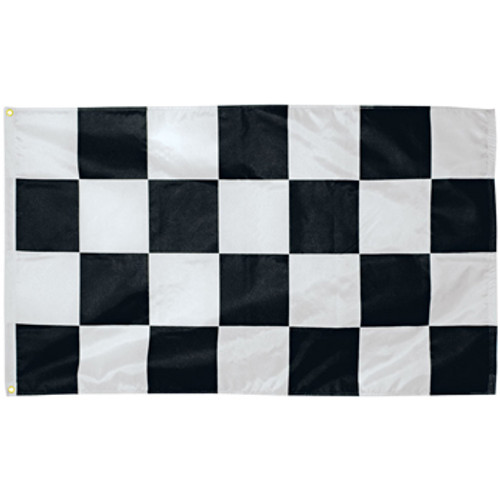
Black & White Lighweight Checkered Flag

Yacht Boat Racing Flag - Blue

Yacht Boat Racing Flag - Black
This is a commercial grade nautical product designed for outdoor use. It is made using our 200 Denier Outdoor Nylon fabric and includes sewn letters and anchor logo. Your flag is finished with a heavy white canvas heading and strong brass grommets.
(Optional - Depends on starting method) - Denotes that orange smoke has been lit and there are 3 minutes or less until the start of the race.
This is a commercial grade nautical product designed for outdoor use. It is made using our 200 Denier Outdoor Nylon fabric and includes sewn letters and anchor logo. Your flag is finished with a heavy white canvas heading and strong brass grommets. ...
Our Checkered, Black & Whit enylon flag. Perfect for racing events, auto shows, estate sales and auctions. Printed on Commercial Grade Nylon material, is strong and sturdy, with a high-gloss look. Includes canvas heading and grommets.
Our Checkered, Black & White poly/cotton flag. Perfect for racing events, auto shows, estate sales and auctions. Printed on poly/cotton material, is strong and sturdy, with a high-gloss look. Includes canvas heading and grommets. In Power Boat...
When displayed the race committee boat is in position at the finishing line.
The Black Flag Rule 30.3 will be in effect. A boat within the triangle formed by the ends of the line and the first mark during the minute before the start will be disqualified without a hearing.

IMAGES
VIDEO
COMMENTS
Calling the O Flag the cheating flag is certainly a bit of a misnomer. The O Flag does, however, suspend Rule 42 of the Racing Rules of Sailing. Rule 42 is particularly notorious, as it bans pumping, rocking, ooching, sculling, and excessive maneuvering, all of which are methods to make your boat go substantially faster.
In sailboat racing, it's crucial to understand the meaning behind these flags and signals to ensure fair competition and maintain the spirit of freedom on the water. Here are three key points to consider: Penalty flags: These flags are raised by race officials to indicate a rule violation by a boat.
Racing flags SAIL Magazine Sailing. Everyone knows the Answering Pennant (AP or "Cat in the Hat" flag) means racing has been postponed and that the "P" flag means a standard starting sequence. But what about the "M" flag, an "N" flag over an "A" flag, or an answering pennant flying above Pennant 2?
racing. and . racing). Each of the terms in the table below is used in . The Racing Rules of Sailing. with the meaning given. Term Meaning . Boat A sailboat and the crew on board. Competitor A person who races or intends to race in the event. National authority A World Sailing member national authority. Race committee
The meanings of visual and sound signals are stated below. An arrow pointing up or down means that a visual signal is displayed or removed. A dot means a sound; five short dashes mean repetitive sounds; a long dash means a long sound. When a visual signal is displayed over a class flag, fleet flat, event flat or race area flag, the signal applies only to that class, fleet or race area.
Sailboat racing is a thrilling and challenging sport that requires skill, strategy, and knowledge of sailing rules and regulations. One of the essential components of sailboat racing is the use of flags and signals to communicate important information to the sailors. Sailboat racing flags and signals are a standardized system used to convey ...
In yacht racing and dinghy racing, flags have other meanings; for example, the P flag is used as the "preparatory" flag to indicate an imminent start, and the S flag means "shortened course" (for more details see Race signals). Sailor prepares signal flags for operations at sea
Flags used in yacht racing. The rules of Yacht Racing are found in the Racing Rules of Sailing (RRS) (which govern the sport of sailing on the water) and the Sailing Instructions Guide. The flags used are called "RRS Race Signals". They are revised and published every four years by World Sailing ). The current edition is "The Racing Rules of ...
The Class Flag goes up at five minutes before the start and remains up until the start. This is a warning flag only. The Rules of Racing (RRS) don't kick in for another minute. It is accompanied by a sound signal. P (Preparatory) flag goes up at four (4) minutes before the start. The P flag is blue with a white, square center.
Racing and boating flags. In racing and boating, specific flags are used to indicate race-related information, rules, and warnings. For example: The "AP" flag (Answering Pennant) displayed before a race indicates a postponement. The "X" flag signals that individual recall is in effect, meaning a participant must return to the starting line.
5.3 Racing and Regatta Flags. In sailing races and regattas, flags play a vital role in indicating the start, finish, and various stages of the race. Each flag has a specific meaning and is used to communicate important instructions and rules to the participating boats. 5.4 Navigational Warnings
Flag/Shape: Name: Sounds: Meaning: Postponement Signals: AP: 2 when raised 1 when lowered: Races not started are postponed. The warning signal will be made 1 minute after removal unless at that time the race is postponed again or abandoned. ... Yacht Club Race Committee Auxiliary Vessel: Yacht Club Officer Flags. Commodore: Vice Commodore: Past ...
Decoding Sailing Flag Colors and Symbols. Colors and symbols within sailing flags are not mere aesthetics; they carry vital meanings that help sailors convey messages effectively. From the bold red of a "C" flag representing "Affirmative" to the stark white and blue of the "H" flag indicating "I have a pilot on board," these ...
signal is displayed over a class flag, fleet flag, event flag or race area flag, the signal applies only to that class, fleet, event or race area. Postponement Signals is abandoned Abandonment Signals Safety AP Races not started are postponed. The warning signal will be made 1 minute after removal unless at that time the race postponed again or .
The International Code of Signals is a standardized system that uses nautical flags to communicate messages between ships. This system uses a combination of signal flags, alphabet flags, and numeral pennants to convey messages. Each flag represents a letter or a number, and the messages are spelled out by stringing together the appropriate flags.
In yacht racing, the nautical flags have other meanings. These ones are solo or combined. The P flag, for example, is employed as the "preparatory" flag to indicate an impending start, while the S flag indicates that a course has been shortened. ... To learn more about nautical flag meanings and communication, you can refer to resources ...
Flag meanings for yacht racing in international waters are determined based on the internationally-understood system of code signal flags and other specialized flags. These flags, such as the yacht club burgee and private signal, represent specific messages or identification for the participating vessels. The use of these standardized flag ...
Preferred Start Boat Flag Layout Start Boat Signals Other Race Committee Signals before the Start Course (flag, pennant, course board, white/blackboard) Y Flag * AP, AP over Numeral 1, 2, 3 etc, AP over H, AP over A ** N, N over H, N over A ***
Yacht flags, in particular, are used to signal the boat's identity, status, or intention. For example, a yellow and blue flag with a white anchor in the center is a signal for a vessel that is at anchor. A white flag with a blue square and a white cross in the center signals that the boat is a medical vessel or has a medical emergency on board.
Six-Flag Signals - Indicate West, East, South, or North in Longitude or Latitude Signals. Seven-Flag Signals - Longitude with more than one-hundred degrees. Nautical flags are also used in racing to communicate messages to competitors. International Nautical Flag Meanings. Each flag representing a letter of the alphabet has a meaning. The ...
Contents of the Rules. The Racing Rules of Sailing were most dramatically simplified in 1997 since the 1940s. The new document contains four main rules [Part 2, Section A]: Boats on a port tack shall keep clear of boats on starboard tack (Rule 10).; When boats are on the same tack and overlapped, the boat to windward (the boat closest to the wind) shall keep clear of a leeward boat (Rule 11).
Click here for a link to "Racing Rules Of Sailing" and usual meanings of racing flags. Sort By: Quick view Details. Race Committee Flag - 20x30 Inches. $54.95. Add to Cart. Quick view Details. Race Committee Flag - 24x36 Inches ... Yacht Boat Racing Flag - Blue. When displayed the race committee boat is in position at the finishing line. $24.50 ...